Case Study on Yorkville Ambulance
VerifiedAdded on 2021/11/23
|22
|6798
|201
AI Summary
Contribute Materials
Your contribution can guide someone’s learning journey. Share your
documents today.
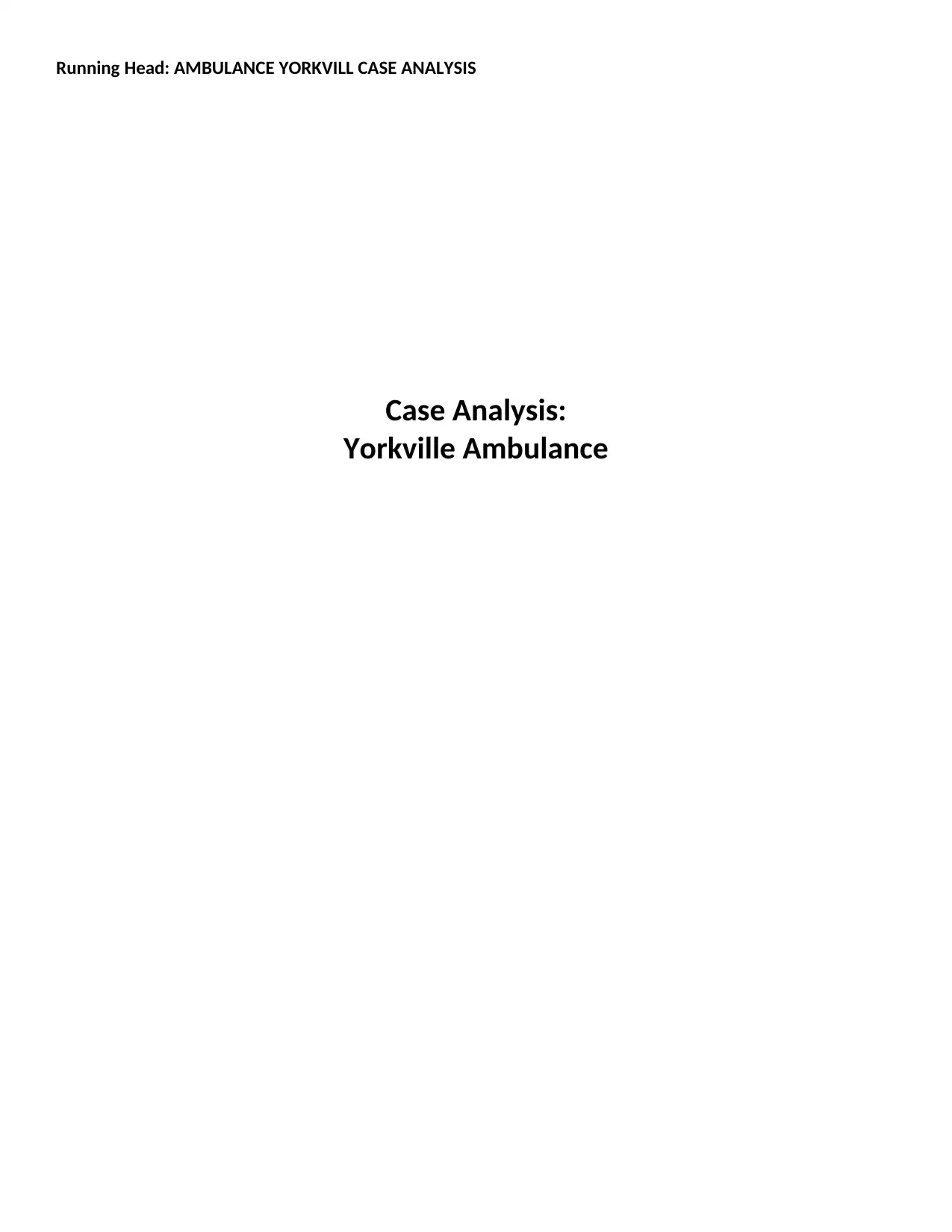
Running Head: AMBULANCE YORKVILL CASE ANALYSIS
Case Analysis:
Yorkville Ambulance
Case Analysis:
Yorkville Ambulance
Secure Best Marks with AI Grader
Need help grading? Try our AI Grader for instant feedback on your assignments.

AMBULANCE YORKVILL CASE ANALYSIS
Case Analysis Form – Ivey
In order to deal with the enormous workload in the organization, The Company seeks
assistance in putting together a sustainable human resource plan. This is simply due to
insufficient time to build relationships with employees. There are two main issues here:
Employee communications and personal leadership. The issues are summarized below:
General Information
AYV is a public company created by the Government of Yorkville in June 2007 to provide
an emergency medical service.
It unifies all ambulance services under a single entity.
A total of about 900 employees work for Ambulance Yorkville, including 850
paramedics, 40 dispatchers, and 15 nurses.
Employee communications
As MCMC and air ambulance representatives are both based in Moncton, they have no
employee communication because their workers are spread out across Yorkville.
Managers on the front line have a heavy burden of administrative duties, such as
scheduling paramedics. Currently, only email can be used to communicate because it is
the easiest way to get a response.
The focus of the collective agreement was more on hospital employees and less on AYV.
Concerns have been raised about the level of engagement by paramedics
A risk of multiple disconnected cultures emerging exists.
HR learned about serious issues too late to have an impact and front-line management
has already acted. Occasionally, HR had to change the manager's position after it had
been made. Thus, there has begun to be friction between HR and Operations.
There are squabbles between dispatch and paramedics. While this is a typical
occurrence in emergency services, it is unsatisfactory and may be getting worse.
Personal leadership
Since paramedics have little opportunity to advance in their organization, they are not
usually driven by advancement. They occasionally express concern about the new
system.
Managers who used to work for private companies are aware of their loss of freedom
now that they work for a larger corporation.
Across the organization, employee experiences vary due to different management styles
among the Operations Managers or Regional Managers.
2
Case Analysis Form – Ivey
In order to deal with the enormous workload in the organization, The Company seeks
assistance in putting together a sustainable human resource plan. This is simply due to
insufficient time to build relationships with employees. There are two main issues here:
Employee communications and personal leadership. The issues are summarized below:
General Information
AYV is a public company created by the Government of Yorkville in June 2007 to provide
an emergency medical service.
It unifies all ambulance services under a single entity.
A total of about 900 employees work for Ambulance Yorkville, including 850
paramedics, 40 dispatchers, and 15 nurses.
Employee communications
As MCMC and air ambulance representatives are both based in Moncton, they have no
employee communication because their workers are spread out across Yorkville.
Managers on the front line have a heavy burden of administrative duties, such as
scheduling paramedics. Currently, only email can be used to communicate because it is
the easiest way to get a response.
The focus of the collective agreement was more on hospital employees and less on AYV.
Concerns have been raised about the level of engagement by paramedics
A risk of multiple disconnected cultures emerging exists.
HR learned about serious issues too late to have an impact and front-line management
has already acted. Occasionally, HR had to change the manager's position after it had
been made. Thus, there has begun to be friction between HR and Operations.
There are squabbles between dispatch and paramedics. While this is a typical
occurrence in emergency services, it is unsatisfactory and may be getting worse.
Personal leadership
Since paramedics have little opportunity to advance in their organization, they are not
usually driven by advancement. They occasionally express concern about the new
system.
Managers who used to work for private companies are aware of their loss of freedom
now that they work for a larger corporation.
Across the organization, employee experiences vary due to different management styles
among the Operations Managers or Regional Managers.
2
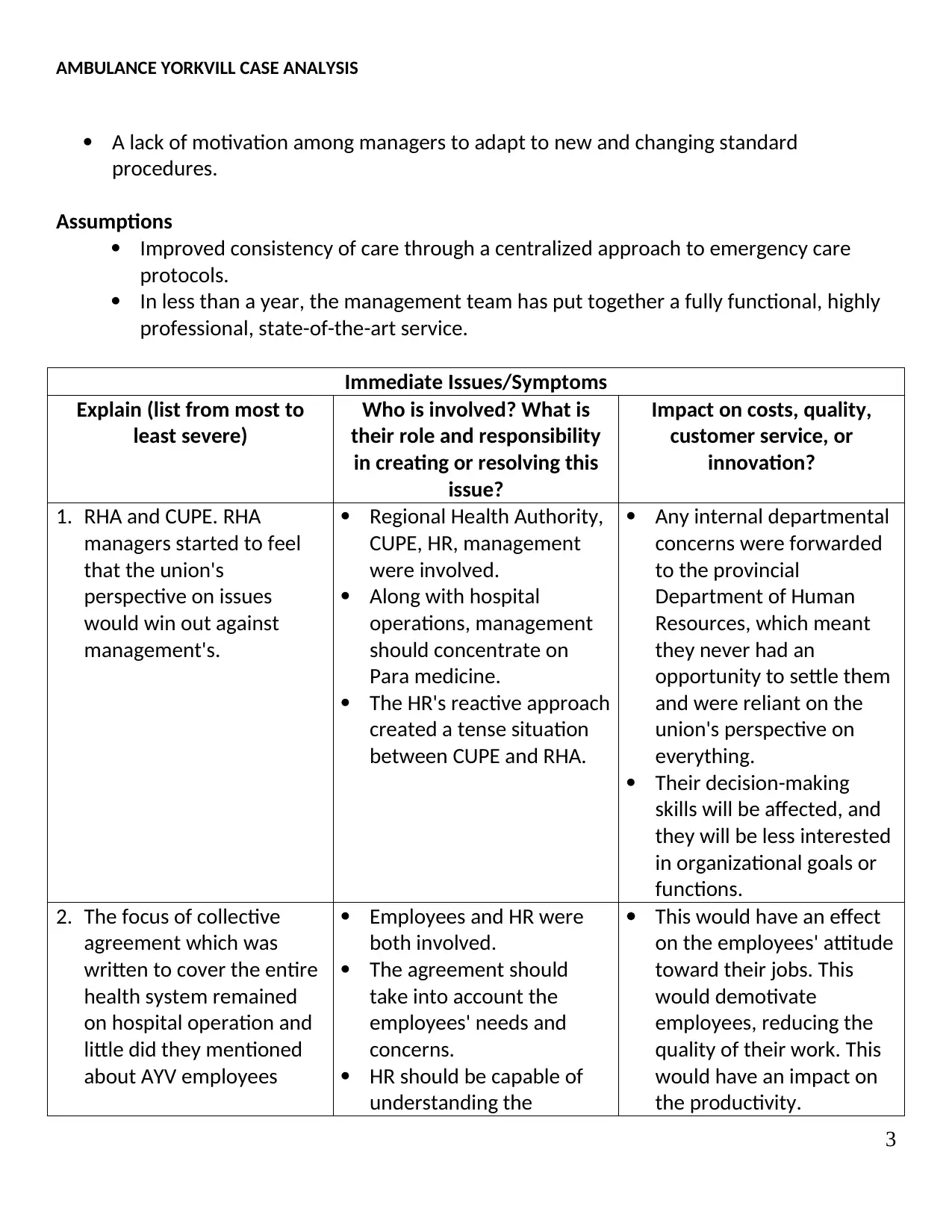
AMBULANCE YORKVILL CASE ANALYSIS
A lack of motivation among managers to adapt to new and changing standard
procedures.
Assumptions
Improved consistency of care through a centralized approach to emergency care
protocols.
In less than a year, the management team has put together a fully functional, highly
professional, state-of-the-art service.
Immediate Issues/Symptoms
Explain (list from most to
least severe)
Who is involved? What is
their role and responsibility
in creating or resolving this
issue?
Impact on costs, quality,
customer service, or
innovation?
1. RHA and CUPE. RHA
managers started to feel
that the union's
perspective on issues
would win out against
management's.
Regional Health Authority,
CUPE, HR, management
were involved.
Along with hospital
operations, management
should concentrate on
Para medicine.
The HR's reactive approach
created a tense situation
between CUPE and RHA.
Any internal departmental
concerns were forwarded
to the provincial
Department of Human
Resources, which meant
they never had an
opportunity to settle them
and were reliant on the
union's perspective on
everything.
Their decision-making
skills will be affected, and
they will be less interested
in organizational goals or
functions.
2. The focus of collective
agreement which was
written to cover the entire
health system remained
on hospital operation and
little did they mentioned
about AYV employees
Employees and HR were
both involved.
The agreement should
take into account the
employees' needs and
concerns.
HR should be capable of
understanding the
This would have an effect
on the employees' attitude
toward their jobs. This
would demotivate
employees, reducing the
quality of their work. This
would have an impact on
the productivity.
3
A lack of motivation among managers to adapt to new and changing standard
procedures.
Assumptions
Improved consistency of care through a centralized approach to emergency care
protocols.
In less than a year, the management team has put together a fully functional, highly
professional, state-of-the-art service.
Immediate Issues/Symptoms
Explain (list from most to
least severe)
Who is involved? What is
their role and responsibility
in creating or resolving this
issue?
Impact on costs, quality,
customer service, or
innovation?
1. RHA and CUPE. RHA
managers started to feel
that the union's
perspective on issues
would win out against
management's.
Regional Health Authority,
CUPE, HR, management
were involved.
Along with hospital
operations, management
should concentrate on
Para medicine.
The HR's reactive approach
created a tense situation
between CUPE and RHA.
Any internal departmental
concerns were forwarded
to the provincial
Department of Human
Resources, which meant
they never had an
opportunity to settle them
and were reliant on the
union's perspective on
everything.
Their decision-making
skills will be affected, and
they will be less interested
in organizational goals or
functions.
2. The focus of collective
agreement which was
written to cover the entire
health system remained
on hospital operation and
little did they mentioned
about AYV employees
Employees and HR were
both involved.
The agreement should
take into account the
employees' needs and
concerns.
HR should be capable of
understanding the
This would have an effect
on the employees' attitude
toward their jobs. This
would demotivate
employees, reducing the
quality of their work. This
would have an impact on
the productivity.
3

AMBULANCE YORKVILL CASE ANALYSIS
situation and develop
suitable strategies as a
result.
Employees that lose focus
on their task have an
impact on customer
service quality.
Failure to meet the
organization's objectives
3. Employee relations are
hampered by the nature of
the business
(They have no employee
communication because
their workers are spread
out across Yorkville.)
Senior managers- Due to a
lack of time, they have
been unable to develop a
strategic human resources
plan.
MCMC and air ambulance
employees- they are
situated primarily in
Moncton, however some
employees are dispersed
around Yorkville.
Front-line managers-
having a large number of
administrative
responsibilities
Employees were not
socialized, causing them to
be estranged from one
another, generating an
unwelcomed atmosphere,
and a feeling of
hopelessness.
Low workplace
productivity and
communication owing to
interpersonal conflict.
There is no team
communication or
engagement to boost job
morale.
4. Concerns over the level of
engagement by
paramedics
Paramedics – they are not
generally motivated by
career progression
As they have few
opportunities to advance
in their companies, they
occasionally voice concern
about the new system.
If they are constantly
demotivated, they would
have less enthusiasm in
their work.
5. Danger of multiple
disconnected cultures
emerging.
Managers- feel their lack
of freedom
Employees- their
experience differs across
the organization, based on
differing management
styles
They have lost the
freedom which they used
to enjoy while working as
an independent contract,
and they now feel bound
to follow sops and yet no
one cares about their
opinion.
4
situation and develop
suitable strategies as a
result.
Employees that lose focus
on their task have an
impact on customer
service quality.
Failure to meet the
organization's objectives
3. Employee relations are
hampered by the nature of
the business
(They have no employee
communication because
their workers are spread
out across Yorkville.)
Senior managers- Due to a
lack of time, they have
been unable to develop a
strategic human resources
plan.
MCMC and air ambulance
employees- they are
situated primarily in
Moncton, however some
employees are dispersed
around Yorkville.
Front-line managers-
having a large number of
administrative
responsibilities
Employees were not
socialized, causing them to
be estranged from one
another, generating an
unwelcomed atmosphere,
and a feeling of
hopelessness.
Low workplace
productivity and
communication owing to
interpersonal conflict.
There is no team
communication or
engagement to boost job
morale.
4. Concerns over the level of
engagement by
paramedics
Paramedics – they are not
generally motivated by
career progression
As they have few
opportunities to advance
in their companies, they
occasionally voice concern
about the new system.
If they are constantly
demotivated, they would
have less enthusiasm in
their work.
5. Danger of multiple
disconnected cultures
emerging.
Managers- feel their lack
of freedom
Employees- their
experience differs across
the organization, based on
differing management
styles
They have lost the
freedom which they used
to enjoy while working as
an independent contract,
and they now feel bound
to follow sops and yet no
one cares about their
opinion.
4
Secure Best Marks with AI Grader
Need help grading? Try our AI Grader for instant feedback on your assignments.
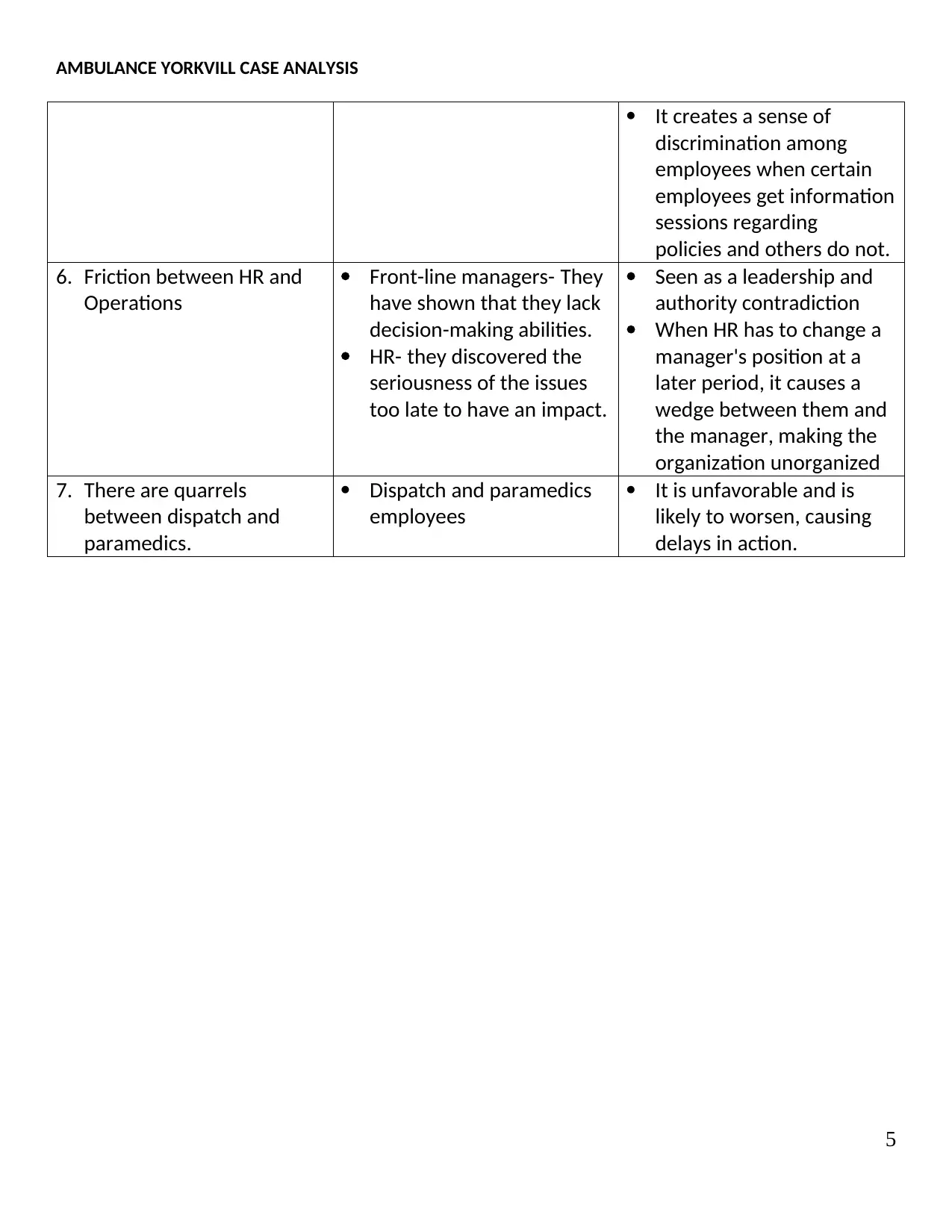
AMBULANCE YORKVILL CASE ANALYSIS
It creates a sense of
discrimination among
employees when certain
employees get information
sessions regarding
policies and others do not.
6. Friction between HR and
Operations
Front-line managers- They
have shown that they lack
decision-making abilities.
HR- they discovered the
seriousness of the issues
too late to have an impact.
Seen as a leadership and
authority contradiction
When HR has to change a
manager's position at a
later period, it causes a
wedge between them and
the manager, making the
organization unorganized
7. There are quarrels
between dispatch and
paramedics.
Dispatch and paramedics
employees
It is unfavorable and is
likely to worsen, causing
delays in action.
5
It creates a sense of
discrimination among
employees when certain
employees get information
sessions regarding
policies and others do not.
6. Friction between HR and
Operations
Front-line managers- They
have shown that they lack
decision-making abilities.
HR- they discovered the
seriousness of the issues
too late to have an impact.
Seen as a leadership and
authority contradiction
When HR has to change a
manager's position at a
later period, it causes a
wedge between them and
the manager, making the
organization unorganized
7. There are quarrels
between dispatch and
paramedics.
Dispatch and paramedics
employees
It is unfavorable and is
likely to worsen, causing
delays in action.
5
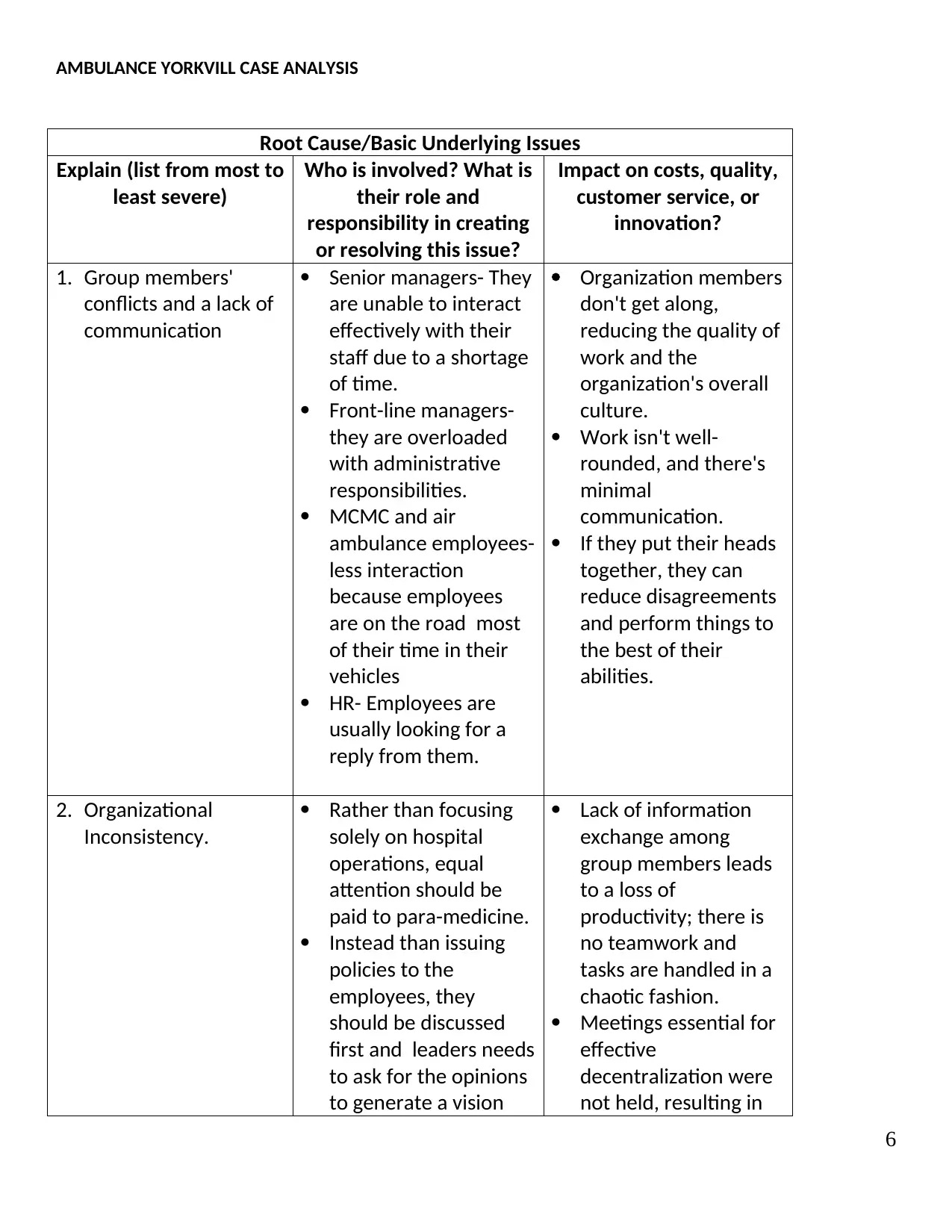
AMBULANCE YORKVILL CASE ANALYSIS
Root Cause/Basic Underlying Issues
Explain (list from most to
least severe)
Who is involved? What is
their role and
responsibility in creating
or resolving this issue?
Impact on costs, quality,
customer service, or
innovation?
1. Group members'
conflicts and a lack of
communication
Senior managers- They
are unable to interact
effectively with their
staff due to a shortage
of time.
Front-line managers-
they are overloaded
with administrative
responsibilities.
MCMC and air
ambulance employees-
less interaction
because employees
are on the road most
of their time in their
vehicles
HR- Employees are
usually looking for a
reply from them.
Organization members
don't get along,
reducing the quality of
work and the
organization's overall
culture.
Work isn't well-
rounded, and there's
minimal
communication.
If they put their heads
together, they can
reduce disagreements
and perform things to
the best of their
abilities.
2. Organizational
Inconsistency.
Rather than focusing
solely on hospital
operations, equal
attention should be
paid to para-medicine.
Instead than issuing
policies to the
employees, they
should be discussed
first and leaders needs
to ask for the opinions
to generate a vision
Lack of information
exchange among
group members leads
to a loss of
productivity; there is
no teamwork and
tasks are handled in a
chaotic fashion.
Meetings essential for
effective
decentralization were
not held, resulting in
6
Root Cause/Basic Underlying Issues
Explain (list from most to
least severe)
Who is involved? What is
their role and
responsibility in creating
or resolving this issue?
Impact on costs, quality,
customer service, or
innovation?
1. Group members'
conflicts and a lack of
communication
Senior managers- They
are unable to interact
effectively with their
staff due to a shortage
of time.
Front-line managers-
they are overloaded
with administrative
responsibilities.
MCMC and air
ambulance employees-
less interaction
because employees
are on the road most
of their time in their
vehicles
HR- Employees are
usually looking for a
reply from them.
Organization members
don't get along,
reducing the quality of
work and the
organization's overall
culture.
Work isn't well-
rounded, and there's
minimal
communication.
If they put their heads
together, they can
reduce disagreements
and perform things to
the best of their
abilities.
2. Organizational
Inconsistency.
Rather than focusing
solely on hospital
operations, equal
attention should be
paid to para-medicine.
Instead than issuing
policies to the
employees, they
should be discussed
first and leaders needs
to ask for the opinions
to generate a vision
Lack of information
exchange among
group members leads
to a loss of
productivity; there is
no teamwork and
tasks are handled in a
chaotic fashion.
Meetings essential for
effective
decentralization were
not held, resulting in
6
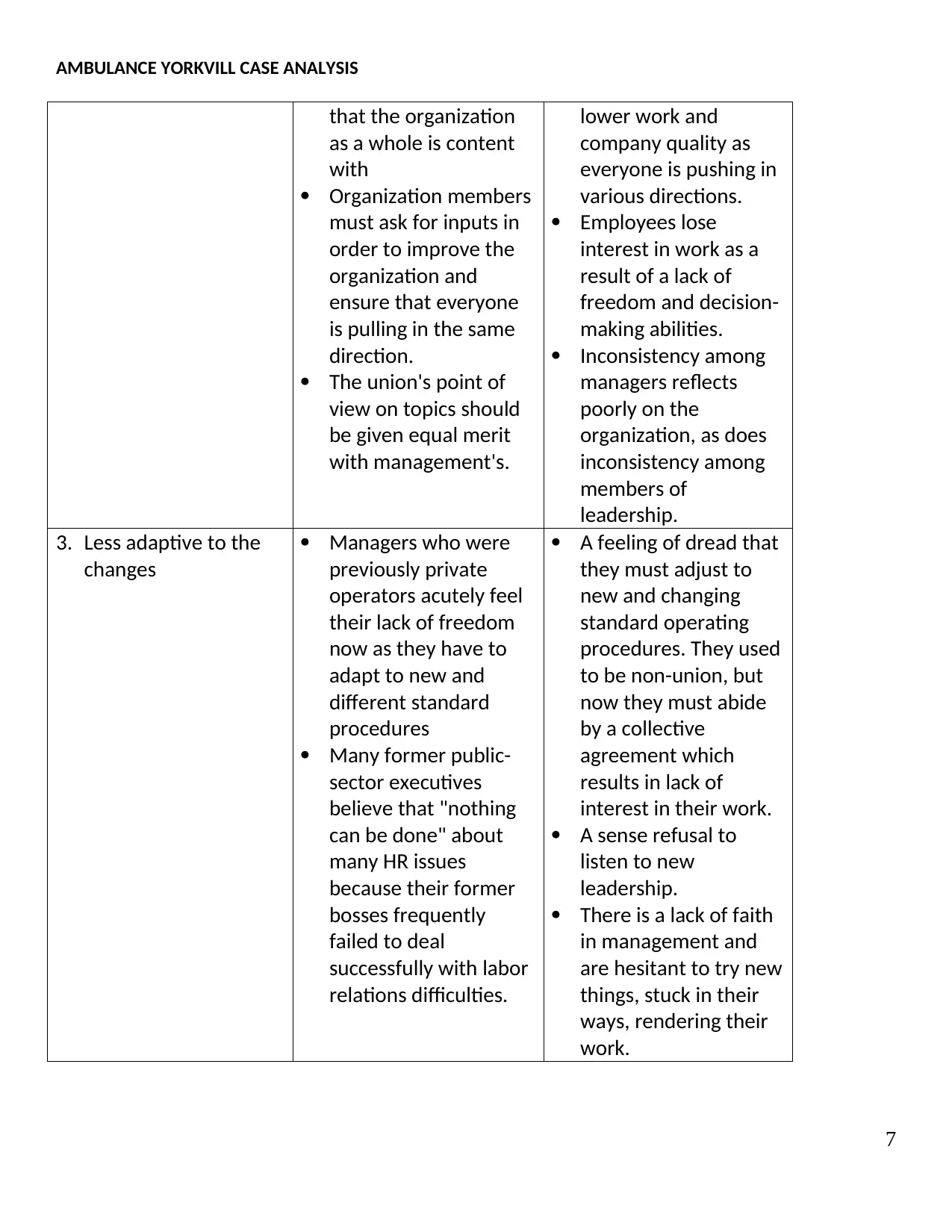
AMBULANCE YORKVILL CASE ANALYSIS
that the organization
as a whole is content
with
Organization members
must ask for inputs in
order to improve the
organization and
ensure that everyone
is pulling in the same
direction.
The union's point of
view on topics should
be given equal merit
with management's.
lower work and
company quality as
everyone is pushing in
various directions.
Employees lose
interest in work as a
result of a lack of
freedom and decision-
making abilities.
Inconsistency among
managers reflects
poorly on the
organization, as does
inconsistency among
members of
leadership.
3. Less adaptive to the
changes
Managers who were
previously private
operators acutely feel
their lack of freedom
now as they have to
adapt to new and
different standard
procedures
Many former public-
sector executives
believe that "nothing
can be done" about
many HR issues
because their former
bosses frequently
failed to deal
successfully with labor
relations difficulties.
A feeling of dread that
they must adjust to
new and changing
standard operating
procedures. They used
to be non-union, but
now they must abide
by a collective
agreement which
results in lack of
interest in their work.
A sense refusal to
listen to new
leadership.
There is a lack of faith
in management and
are hesitant to try new
things, stuck in their
ways, rendering their
work.
7
that the organization
as a whole is content
with
Organization members
must ask for inputs in
order to improve the
organization and
ensure that everyone
is pulling in the same
direction.
The union's point of
view on topics should
be given equal merit
with management's.
lower work and
company quality as
everyone is pushing in
various directions.
Employees lose
interest in work as a
result of a lack of
freedom and decision-
making abilities.
Inconsistency among
managers reflects
poorly on the
organization, as does
inconsistency among
members of
leadership.
3. Less adaptive to the
changes
Managers who were
previously private
operators acutely feel
their lack of freedom
now as they have to
adapt to new and
different standard
procedures
Many former public-
sector executives
believe that "nothing
can be done" about
many HR issues
because their former
bosses frequently
failed to deal
successfully with labor
relations difficulties.
A feeling of dread that
they must adjust to
new and changing
standard operating
procedures. They used
to be non-union, but
now they must abide
by a collective
agreement which
results in lack of
interest in their work.
A sense refusal to
listen to new
leadership.
There is a lack of faith
in management and
are hesitant to try new
things, stuck in their
ways, rendering their
work.
7
Paraphrase This Document
Need a fresh take? Get an instant paraphrase of this document with our AI Paraphraser
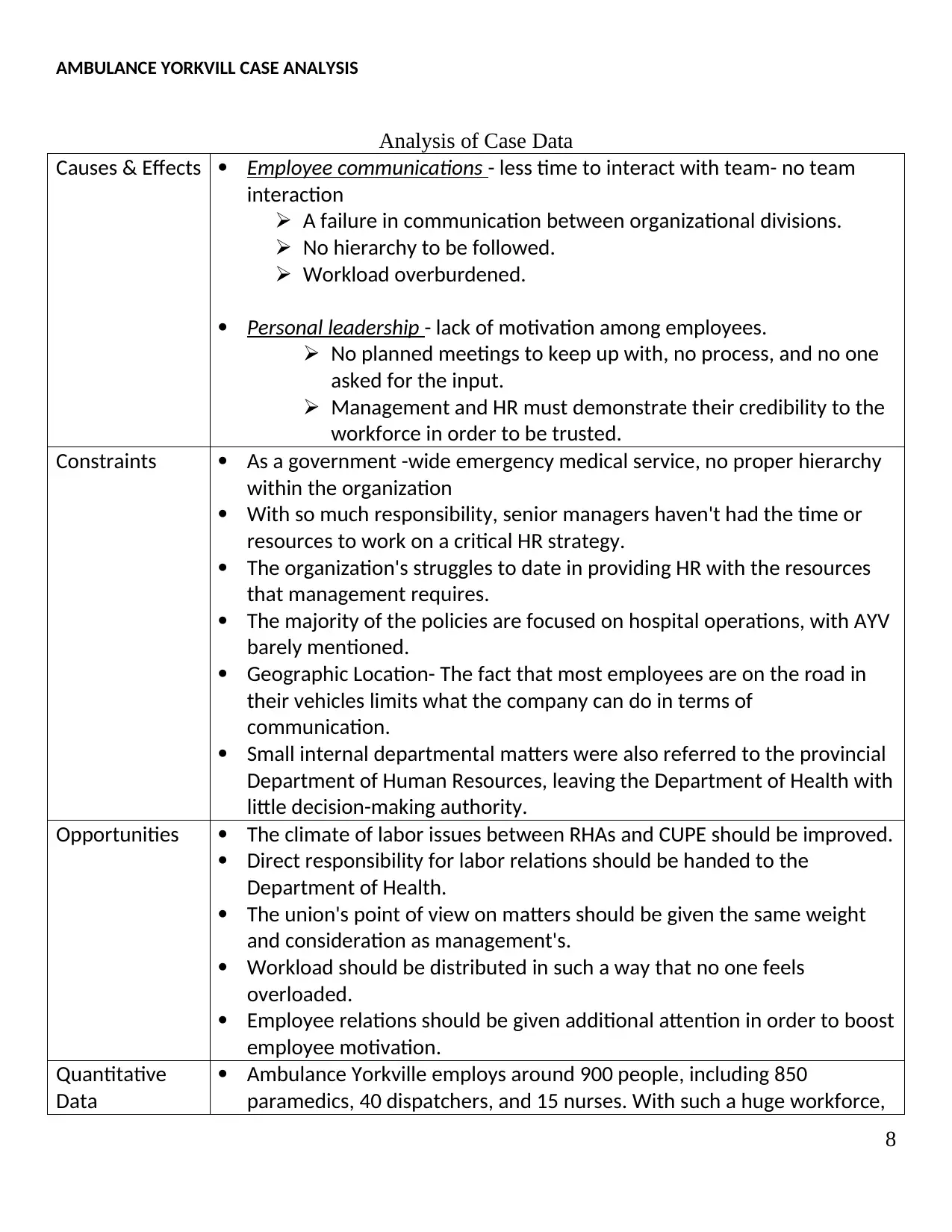
AMBULANCE YORKVILL CASE ANALYSIS
Analysis of Case Data
Causes & Effects Employee communications - less time to interact with team- no team
interaction
A failure in communication between organizational divisions.
No hierarchy to be followed.
Workload overburdened.
Personal leadership - lack of motivation among employees.
No planned meetings to keep up with, no process, and no one
asked for the input.
Management and HR must demonstrate their credibility to the
workforce in order to be trusted.
Constraints As a government -wide emergency medical service, no proper hierarchy
within the organization
With so much responsibility, senior managers haven't had the time or
resources to work on a critical HR strategy.
The organization's struggles to date in providing HR with the resources
that management requires.
The majority of the policies are focused on hospital operations, with AYV
barely mentioned.
Geographic Location- The fact that most employees are on the road in
their vehicles limits what the company can do in terms of
communication.
Small internal departmental matters were also referred to the provincial
Department of Human Resources, leaving the Department of Health with
little decision-making authority.
Opportunities The climate of labor issues between RHAs and CUPE should be improved.
Direct responsibility for labor relations should be handed to the
Department of Health.
The union's point of view on matters should be given the same weight
and consideration as management's.
Workload should be distributed in such a way that no one feels
overloaded.
Employee relations should be given additional attention in order to boost
employee motivation.
Quantitative
Data
Ambulance Yorkville employs around 900 people, including 850
paramedics, 40 dispatchers, and 15 nurses. With such a huge workforce,
8
Analysis of Case Data
Causes & Effects Employee communications - less time to interact with team- no team
interaction
A failure in communication between organizational divisions.
No hierarchy to be followed.
Workload overburdened.
Personal leadership - lack of motivation among employees.
No planned meetings to keep up with, no process, and no one
asked for the input.
Management and HR must demonstrate their credibility to the
workforce in order to be trusted.
Constraints As a government -wide emergency medical service, no proper hierarchy
within the organization
With so much responsibility, senior managers haven't had the time or
resources to work on a critical HR strategy.
The organization's struggles to date in providing HR with the resources
that management requires.
The majority of the policies are focused on hospital operations, with AYV
barely mentioned.
Geographic Location- The fact that most employees are on the road in
their vehicles limits what the company can do in terms of
communication.
Small internal departmental matters were also referred to the provincial
Department of Human Resources, leaving the Department of Health with
little decision-making authority.
Opportunities The climate of labor issues between RHAs and CUPE should be improved.
Direct responsibility for labor relations should be handed to the
Department of Health.
The union's point of view on matters should be given the same weight
and consideration as management's.
Workload should be distributed in such a way that no one feels
overloaded.
Employee relations should be given additional attention in order to boost
employee motivation.
Quantitative
Data
Ambulance Yorkville employs around 900 people, including 850
paramedics, 40 dispatchers, and 15 nurses. With such a huge workforce,
8
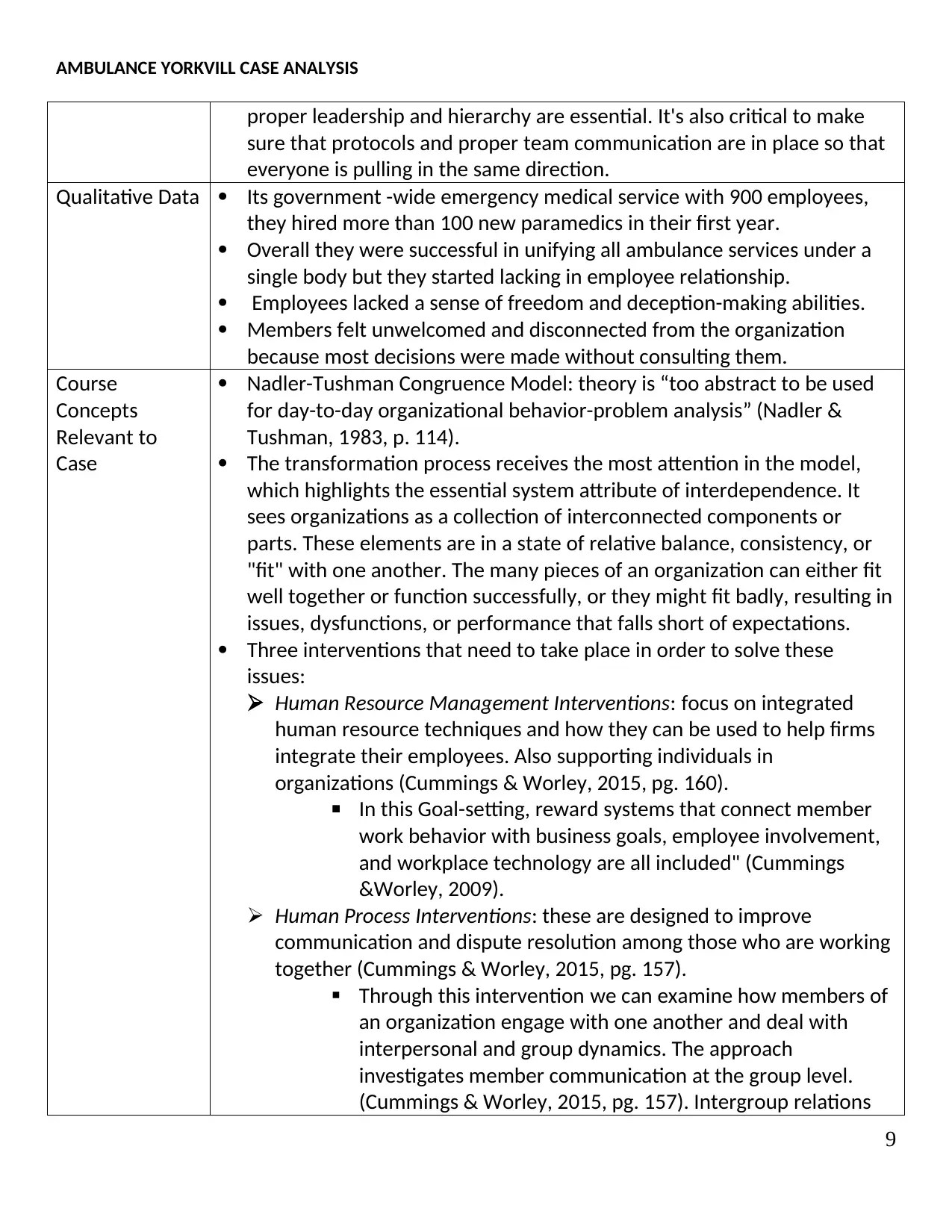
AMBULANCE YORKVILL CASE ANALYSIS
proper leadership and hierarchy are essential. It's also critical to make
sure that protocols and proper team communication are in place so that
everyone is pulling in the same direction.
Qualitative Data Its government -wide emergency medical service with 900 employees,
they hired more than 100 new paramedics in their first year.
Overall they were successful in unifying all ambulance services under a
single body but they started lacking in employee relationship.
Employees lacked a sense of freedom and deception-making abilities.
Members felt unwelcomed and disconnected from the organization
because most decisions were made without consulting them.
Course
Concepts
Relevant to
Case
Nadler-Tushman Congruence Model: theory is “too abstract to be used
for day-to-day organizational behavior-problem analysis” (Nadler &
Tushman, 1983, p. 114).
The transformation process receives the most attention in the model,
which highlights the essential system attribute of interdependence. It
sees organizations as a collection of interconnected components or
parts. These elements are in a state of relative balance, consistency, or
"fit" with one another. The many pieces of an organization can either fit
well together or function successfully, or they might fit badly, resulting in
issues, dysfunctions, or performance that falls short of expectations.
Three interventions that need to take place in order to solve these
issues:
Human Resource Management Interventions: focus on integrated
human resource techniques and how they can be used to help firms
integrate their employees. Also supporting individuals in
organizations (Cummings & Worley, 2015, pg. 160).
In this Goal-setting, reward systems that connect member
work behavior with business goals, employee involvement,
and workplace technology are all included" (Cummings
&Worley, 2009).
Human Process Interventions: these are designed to improve
communication and dispute resolution among those who are working
together (Cummings & Worley, 2015, pg. 157).
Through this intervention we can examine how members of
an organization engage with one another and deal with
interpersonal and group dynamics. The approach
investigates member communication at the group level.
(Cummings & Worley, 2015, pg. 157). Intergroup relations
9
proper leadership and hierarchy are essential. It's also critical to make
sure that protocols and proper team communication are in place so that
everyone is pulling in the same direction.
Qualitative Data Its government -wide emergency medical service with 900 employees,
they hired more than 100 new paramedics in their first year.
Overall they were successful in unifying all ambulance services under a
single body but they started lacking in employee relationship.
Employees lacked a sense of freedom and deception-making abilities.
Members felt unwelcomed and disconnected from the organization
because most decisions were made without consulting them.
Course
Concepts
Relevant to
Case
Nadler-Tushman Congruence Model: theory is “too abstract to be used
for day-to-day organizational behavior-problem analysis” (Nadler &
Tushman, 1983, p. 114).
The transformation process receives the most attention in the model,
which highlights the essential system attribute of interdependence. It
sees organizations as a collection of interconnected components or
parts. These elements are in a state of relative balance, consistency, or
"fit" with one another. The many pieces of an organization can either fit
well together or function successfully, or they might fit badly, resulting in
issues, dysfunctions, or performance that falls short of expectations.
Three interventions that need to take place in order to solve these
issues:
Human Resource Management Interventions: focus on integrated
human resource techniques and how they can be used to help firms
integrate their employees. Also supporting individuals in
organizations (Cummings & Worley, 2015, pg. 160).
In this Goal-setting, reward systems that connect member
work behavior with business goals, employee involvement,
and workplace technology are all included" (Cummings
&Worley, 2009).
Human Process Interventions: these are designed to improve
communication and dispute resolution among those who are working
together (Cummings & Worley, 2015, pg. 157).
Through this intervention we can examine how members of
an organization engage with one another and deal with
interpersonal and group dynamics. The approach
investigates member communication at the group level.
(Cummings & Worley, 2015, pg. 157). Intergroup relations
9

AMBULANCE YORKVILL CASE ANALYSIS
and large-group interventions will aid in the formation of
ties between workforce divisions as well as the explanation
of essential group values and goals. (Cummings & Worley,
2015, pg. 158).
Strategic Change Interventions: implemented to enhance “business
strategy, organization structure, and the larger environment”
connectivity (Cummings & Worley, 2015, pg. 161).
Remodeling the organizational design, covering structure,
rules, and management processes, as well as participating in
a cultural shift that involves the creation of new values,
norms, and goals (Cummings & Worley, 2015, pg. 161)
The theory of strategic change and change management, and manifested
in part in the practice of transformational change, or reengineering.
When a company needs to modify its strategy to be more competitive, it
must make both external and internal changes, as employees must be
informed, involved, and motivated to help achieve the change (Worley,
Hitchin, & Ross, 1996). It is a methodical way to dealing with change, not
only from the perspective of an organization, but also from the
perspective of an individual. Change management is a broad word that
encompasses more than three dimensions, including adjusting to
change, controlling change, and implementing change.
10
and large-group interventions will aid in the formation of
ties between workforce divisions as well as the explanation
of essential group values and goals. (Cummings & Worley,
2015, pg. 158).
Strategic Change Interventions: implemented to enhance “business
strategy, organization structure, and the larger environment”
connectivity (Cummings & Worley, 2015, pg. 161).
Remodeling the organizational design, covering structure,
rules, and management processes, as well as participating in
a cultural shift that involves the creation of new values,
norms, and goals (Cummings & Worley, 2015, pg. 161)
The theory of strategic change and change management, and manifested
in part in the practice of transformational change, or reengineering.
When a company needs to modify its strategy to be more competitive, it
must make both external and internal changes, as employees must be
informed, involved, and motivated to help achieve the change (Worley,
Hitchin, & Ross, 1996). It is a methodical way to dealing with change, not
only from the perspective of an organization, but also from the
perspective of an individual. Change management is a broad word that
encompasses more than three dimensions, including adjusting to
change, controlling change, and implementing change.
10
Secure Best Marks with AI Grader
Need help grading? Try our AI Grader for instant feedback on your assignments.
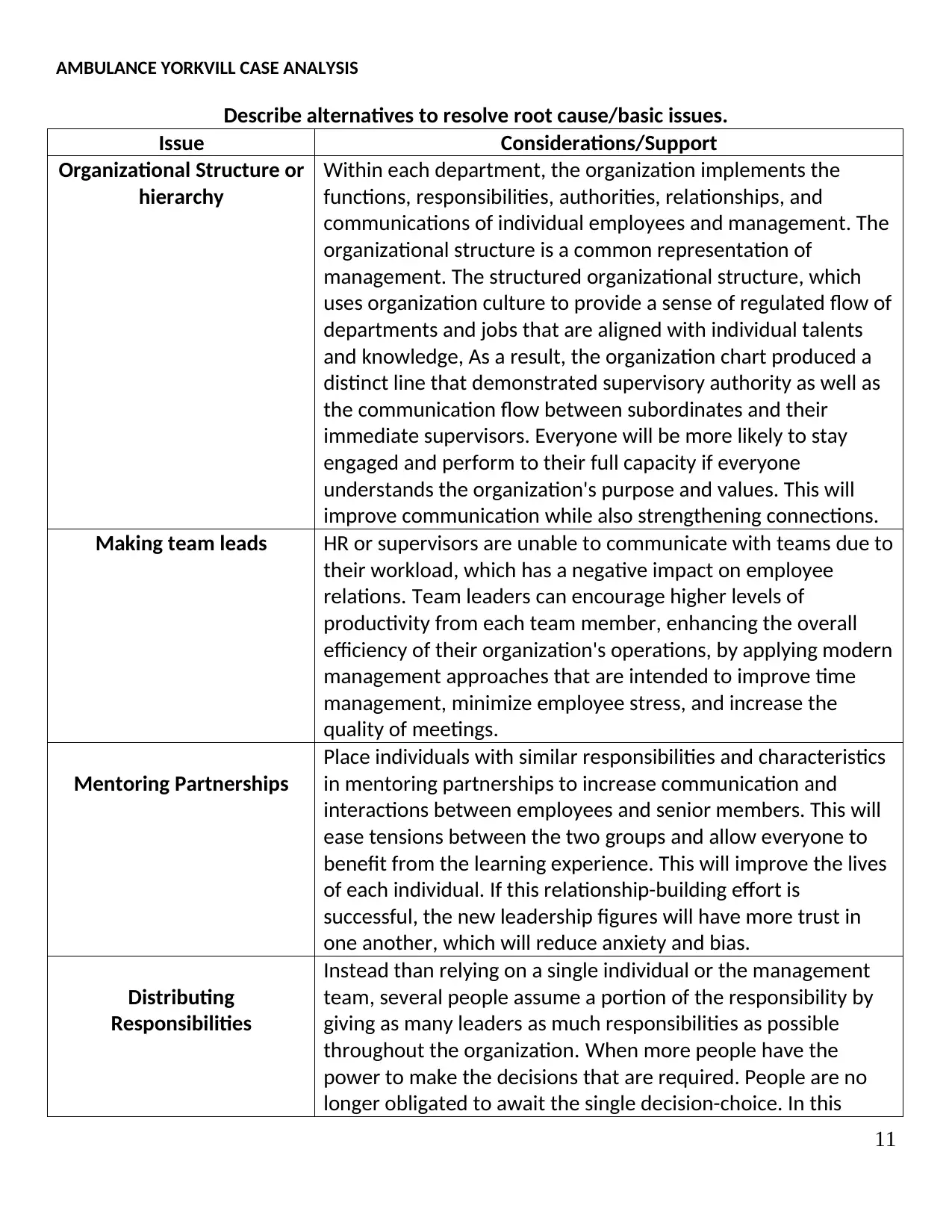
AMBULANCE YORKVILL CASE ANALYSIS
Describe alternatives to resolve root cause/basic issues.
Issue Considerations/Support
Organizational Structure or
hierarchy
Within each department, the organization implements the
functions, responsibilities, authorities, relationships, and
communications of individual employees and management. The
organizational structure is a common representation of
management. The structured organizational structure, which
uses organization culture to provide a sense of regulated flow of
departments and jobs that are aligned with individual talents
and knowledge, As a result, the organization chart produced a
distinct line that demonstrated supervisory authority as well as
the communication flow between subordinates and their
immediate supervisors. Everyone will be more likely to stay
engaged and perform to their full capacity if everyone
understands the organization's purpose and values. This will
improve communication while also strengthening connections.
Making team leads HR or supervisors are unable to communicate with teams due to
their workload, which has a negative impact on employee
relations. Team leaders can encourage higher levels of
productivity from each team member, enhancing the overall
efficiency of their organization's operations, by applying modern
management approaches that are intended to improve time
management, minimize employee stress, and increase the
quality of meetings.
Mentoring Partnerships
Place individuals with similar responsibilities and characteristics
in mentoring partnerships to increase communication and
interactions between employees and senior members. This will
ease tensions between the two groups and allow everyone to
benefit from the learning experience. This will improve the lives
of each individual. If this relationship-building effort is
successful, the new leadership figures will have more trust in
one another, which will reduce anxiety and bias.
Distributing
Responsibilities
Instead than relying on a single individual or the management
team, several people assume a portion of the responsibility by
giving as many leaders as much responsibilities as possible
throughout the organization. When more people have the
power to make the decisions that are required. People are no
longer obligated to await the single decision-choice. In this
11
Describe alternatives to resolve root cause/basic issues.
Issue Considerations/Support
Organizational Structure or
hierarchy
Within each department, the organization implements the
functions, responsibilities, authorities, relationships, and
communications of individual employees and management. The
organizational structure is a common representation of
management. The structured organizational structure, which
uses organization culture to provide a sense of regulated flow of
departments and jobs that are aligned with individual talents
and knowledge, As a result, the organization chart produced a
distinct line that demonstrated supervisory authority as well as
the communication flow between subordinates and their
immediate supervisors. Everyone will be more likely to stay
engaged and perform to their full capacity if everyone
understands the organization's purpose and values. This will
improve communication while also strengthening connections.
Making team leads HR or supervisors are unable to communicate with teams due to
their workload, which has a negative impact on employee
relations. Team leaders can encourage higher levels of
productivity from each team member, enhancing the overall
efficiency of their organization's operations, by applying modern
management approaches that are intended to improve time
management, minimize employee stress, and increase the
quality of meetings.
Mentoring Partnerships
Place individuals with similar responsibilities and characteristics
in mentoring partnerships to increase communication and
interactions between employees and senior members. This will
ease tensions between the two groups and allow everyone to
benefit from the learning experience. This will improve the lives
of each individual. If this relationship-building effort is
successful, the new leadership figures will have more trust in
one another, which will reduce anxiety and bias.
Distributing
Responsibilities
Instead than relying on a single individual or the management
team, several people assume a portion of the responsibility by
giving as many leaders as much responsibilities as possible
throughout the organization. When more people have the
power to make the decisions that are required. People are no
longer obligated to await the single decision-choice. In this
11
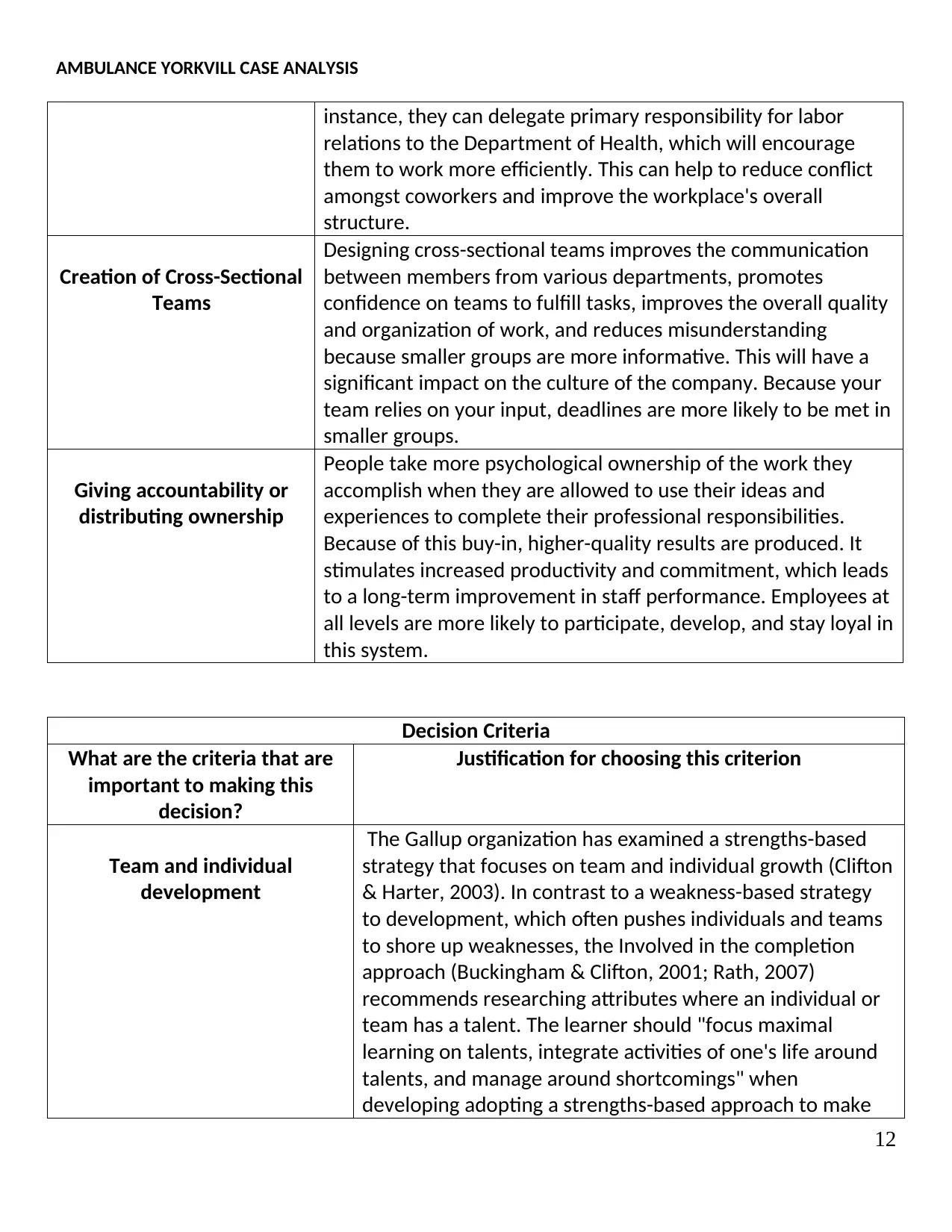
AMBULANCE YORKVILL CASE ANALYSIS
instance, they can delegate primary responsibility for labor
relations to the Department of Health, which will encourage
them to work more efficiently. This can help to reduce conflict
amongst coworkers and improve the workplace's overall
structure.
Creation of Cross-Sectional
Teams
Designing cross-sectional teams improves the communication
between members from various departments, promotes
confidence on teams to fulfill tasks, improves the overall quality
and organization of work, and reduces misunderstanding
because smaller groups are more informative. This will have a
significant impact on the culture of the company. Because your
team relies on your input, deadlines are more likely to be met in
smaller groups.
Giving accountability or
distributing ownership
People take more psychological ownership of the work they
accomplish when they are allowed to use their ideas and
experiences to complete their professional responsibilities.
Because of this buy-in, higher-quality results are produced. It
stimulates increased productivity and commitment, which leads
to a long-term improvement in staff performance. Employees at
all levels are more likely to participate, develop, and stay loyal in
this system.
Decision Criteria
What are the criteria that are
important to making this
decision?
Justification for choosing this criterion
Team and individual
development
The Gallup organization has examined a strengths-based
strategy that focuses on team and individual growth (Clifton
& Harter, 2003). In contrast to a weakness-based strategy
to development, which often pushes individuals and teams
to shore up weaknesses, the Involved in the completion
approach (Buckingham & Clifton, 2001; Rath, 2007)
recommends researching attributes where an individual or
team has a talent. The learner should "focus maximal
learning on talents, integrate activities of one's life around
talents, and manage around shortcomings" when
developing adopting a strengths-based approach to make
12
instance, they can delegate primary responsibility for labor
relations to the Department of Health, which will encourage
them to work more efficiently. This can help to reduce conflict
amongst coworkers and improve the workplace's overall
structure.
Creation of Cross-Sectional
Teams
Designing cross-sectional teams improves the communication
between members from various departments, promotes
confidence on teams to fulfill tasks, improves the overall quality
and organization of work, and reduces misunderstanding
because smaller groups are more informative. This will have a
significant impact on the culture of the company. Because your
team relies on your input, deadlines are more likely to be met in
smaller groups.
Giving accountability or
distributing ownership
People take more psychological ownership of the work they
accomplish when they are allowed to use their ideas and
experiences to complete their professional responsibilities.
Because of this buy-in, higher-quality results are produced. It
stimulates increased productivity and commitment, which leads
to a long-term improvement in staff performance. Employees at
all levels are more likely to participate, develop, and stay loyal in
this system.
Decision Criteria
What are the criteria that are
important to making this
decision?
Justification for choosing this criterion
Team and individual
development
The Gallup organization has examined a strengths-based
strategy that focuses on team and individual growth (Clifton
& Harter, 2003). In contrast to a weakness-based strategy
to development, which often pushes individuals and teams
to shore up weaknesses, the Involved in the completion
approach (Buckingham & Clifton, 2001; Rath, 2007)
recommends researching attributes where an individual or
team has a talent. The learner should "focus maximal
learning on talents, integrate activities of one's life around
talents, and manage around shortcomings" when
developing adopting a strengths-based approach to make
12
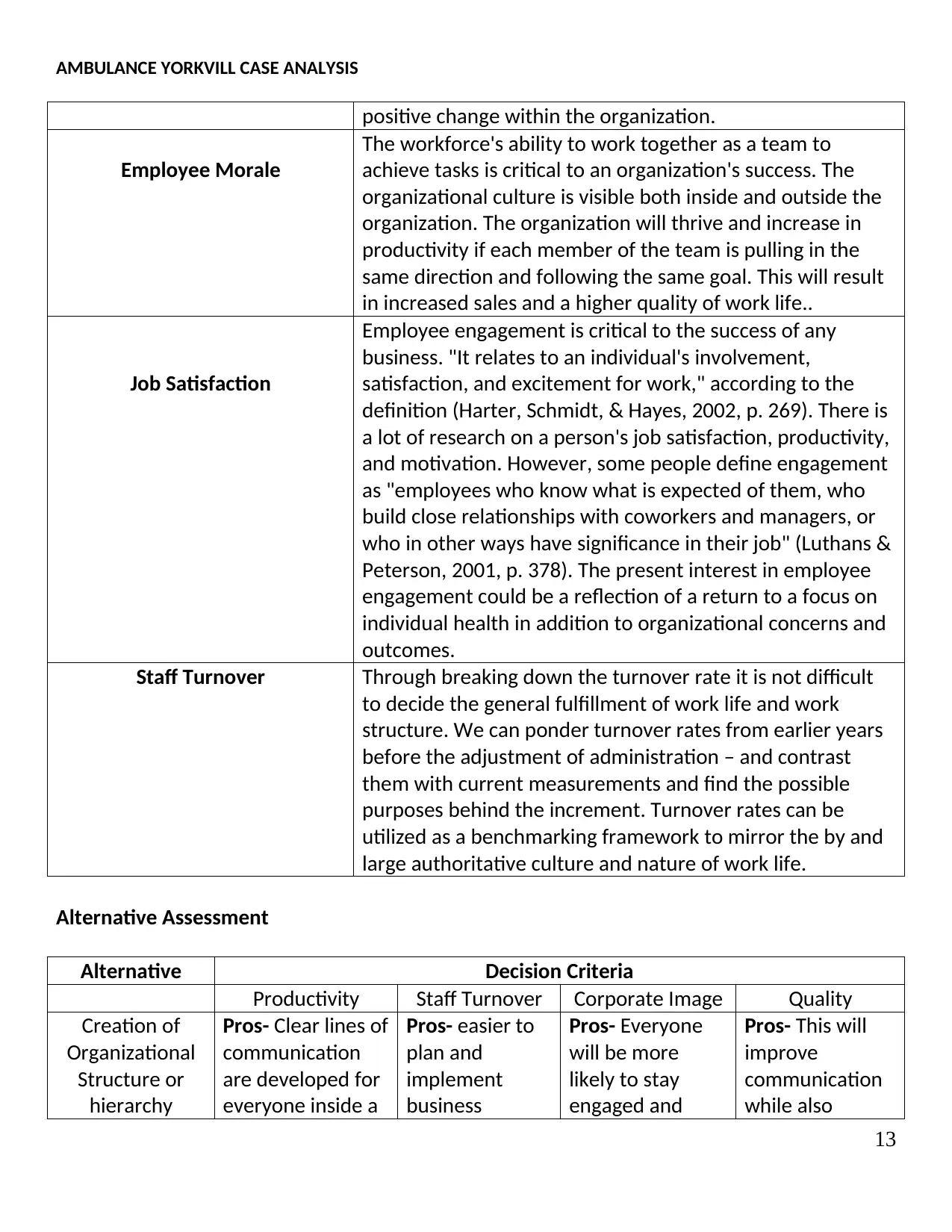
AMBULANCE YORKVILL CASE ANALYSIS
positive change within the organization.
Employee Morale
The workforce's ability to work together as a team to
achieve tasks is critical to an organization's success. The
organizational culture is visible both inside and outside the
organization. The organization will thrive and increase in
productivity if each member of the team is pulling in the
same direction and following the same goal. This will result
in increased sales and a higher quality of work life..
Job Satisfaction
Employee engagement is critical to the success of any
business. "It relates to an individual's involvement,
satisfaction, and excitement for work," according to the
definition (Harter, Schmidt, & Hayes, 2002, p. 269). There is
a lot of research on a person's job satisfaction, productivity,
and motivation. However, some people define engagement
as "employees who know what is expected of them, who
build close relationships with coworkers and managers, or
who in other ways have significance in their job" (Luthans &
Peterson, 2001, p. 378). The present interest in employee
engagement could be a reflection of a return to a focus on
individual health in addition to organizational concerns and
outcomes.
Staff Turnover Through breaking down the turnover rate it is not difficult
to decide the general fulfillment of work life and work
structure. We can ponder turnover rates from earlier years
before the adjustment of administration – and contrast
them with current measurements and find the possible
purposes behind the increment. Turnover rates can be
utilized as a benchmarking framework to mirror the by and
large authoritative culture and nature of work life.
Alternative Assessment
Alternative Decision Criteria
Productivity Staff Turnover Corporate Image Quality
Creation of
Organizational
Structure or
hierarchy
Pros- Clear lines of
communication
are developed for
everyone inside a
Pros- easier to
plan and
implement
business
Pros- Everyone
will be more
likely to stay
engaged and
Pros- This will
improve
communication
while also
13
positive change within the organization.
Employee Morale
The workforce's ability to work together as a team to
achieve tasks is critical to an organization's success. The
organizational culture is visible both inside and outside the
organization. The organization will thrive and increase in
productivity if each member of the team is pulling in the
same direction and following the same goal. This will result
in increased sales and a higher quality of work life..
Job Satisfaction
Employee engagement is critical to the success of any
business. "It relates to an individual's involvement,
satisfaction, and excitement for work," according to the
definition (Harter, Schmidt, & Hayes, 2002, p. 269). There is
a lot of research on a person's job satisfaction, productivity,
and motivation. However, some people define engagement
as "employees who know what is expected of them, who
build close relationships with coworkers and managers, or
who in other ways have significance in their job" (Luthans &
Peterson, 2001, p. 378). The present interest in employee
engagement could be a reflection of a return to a focus on
individual health in addition to organizational concerns and
outcomes.
Staff Turnover Through breaking down the turnover rate it is not difficult
to decide the general fulfillment of work life and work
structure. We can ponder turnover rates from earlier years
before the adjustment of administration – and contrast
them with current measurements and find the possible
purposes behind the increment. Turnover rates can be
utilized as a benchmarking framework to mirror the by and
large authoritative culture and nature of work life.
Alternative Assessment
Alternative Decision Criteria
Productivity Staff Turnover Corporate Image Quality
Creation of
Organizational
Structure or
hierarchy
Pros- Clear lines of
communication
are developed for
everyone inside a
Pros- easier to
plan and
implement
business
Pros- Everyone
will be more
likely to stay
engaged and
Pros- This will
improve
communication
while also
13
Paraphrase This Document
Need a fresh take? Get an instant paraphrase of this document with our AI Paraphraser
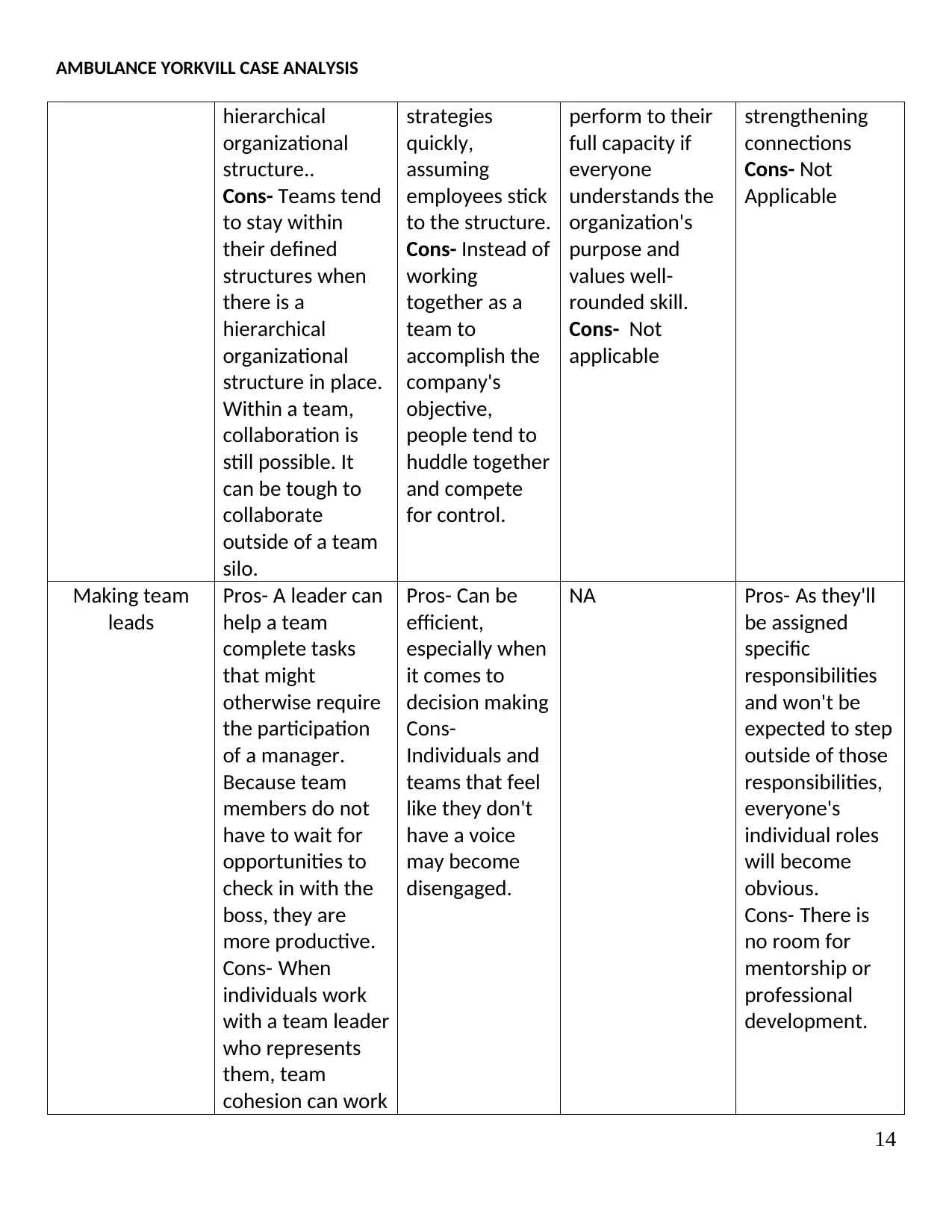
AMBULANCE YORKVILL CASE ANALYSIS
hierarchical
organizational
structure..
Cons- Teams tend
to stay within
their defined
structures when
there is a
hierarchical
organizational
structure in place.
Within a team,
collaboration is
still possible. It
can be tough to
collaborate
outside of a team
silo.
strategies
quickly,
assuming
employees stick
to the structure.
Cons- Instead of
working
together as a
team to
accomplish the
company's
objective,
people tend to
huddle together
and compete
for control.
perform to their
full capacity if
everyone
understands the
organization's
purpose and
values well-
rounded skill.
Cons- Not
applicable
strengthening
connections
Cons- Not
Applicable
Making team
leads
Pros- A leader can
help a team
complete tasks
that might
otherwise require
the participation
of a manager.
Because team
members do not
have to wait for
opportunities to
check in with the
boss, they are
more productive.
Cons- When
individuals work
with a team leader
who represents
them, team
cohesion can work
Pros- Can be
efficient,
especially when
it comes to
decision making
Cons-
Individuals and
teams that feel
like they don't
have a voice
may become
disengaged.
NA Pros- As they'll
be assigned
specific
responsibilities
and won't be
expected to step
outside of those
responsibilities,
everyone's
individual roles
will become
obvious.
Cons- There is
no room for
mentorship or
professional
development.
14
hierarchical
organizational
structure..
Cons- Teams tend
to stay within
their defined
structures when
there is a
hierarchical
organizational
structure in place.
Within a team,
collaboration is
still possible. It
can be tough to
collaborate
outside of a team
silo.
strategies
quickly,
assuming
employees stick
to the structure.
Cons- Instead of
working
together as a
team to
accomplish the
company's
objective,
people tend to
huddle together
and compete
for control.
perform to their
full capacity if
everyone
understands the
organization's
purpose and
values well-
rounded skill.
Cons- Not
applicable
strengthening
connections
Cons- Not
Applicable
Making team
leads
Pros- A leader can
help a team
complete tasks
that might
otherwise require
the participation
of a manager.
Because team
members do not
have to wait for
opportunities to
check in with the
boss, they are
more productive.
Cons- When
individuals work
with a team leader
who represents
them, team
cohesion can work
Pros- Can be
efficient,
especially when
it comes to
decision making
Cons-
Individuals and
teams that feel
like they don't
have a voice
may become
disengaged.
NA Pros- As they'll
be assigned
specific
responsibilities
and won't be
expected to step
outside of those
responsibilities,
everyone's
individual roles
will become
obvious.
Cons- There is
no room for
mentorship or
professional
development.
14
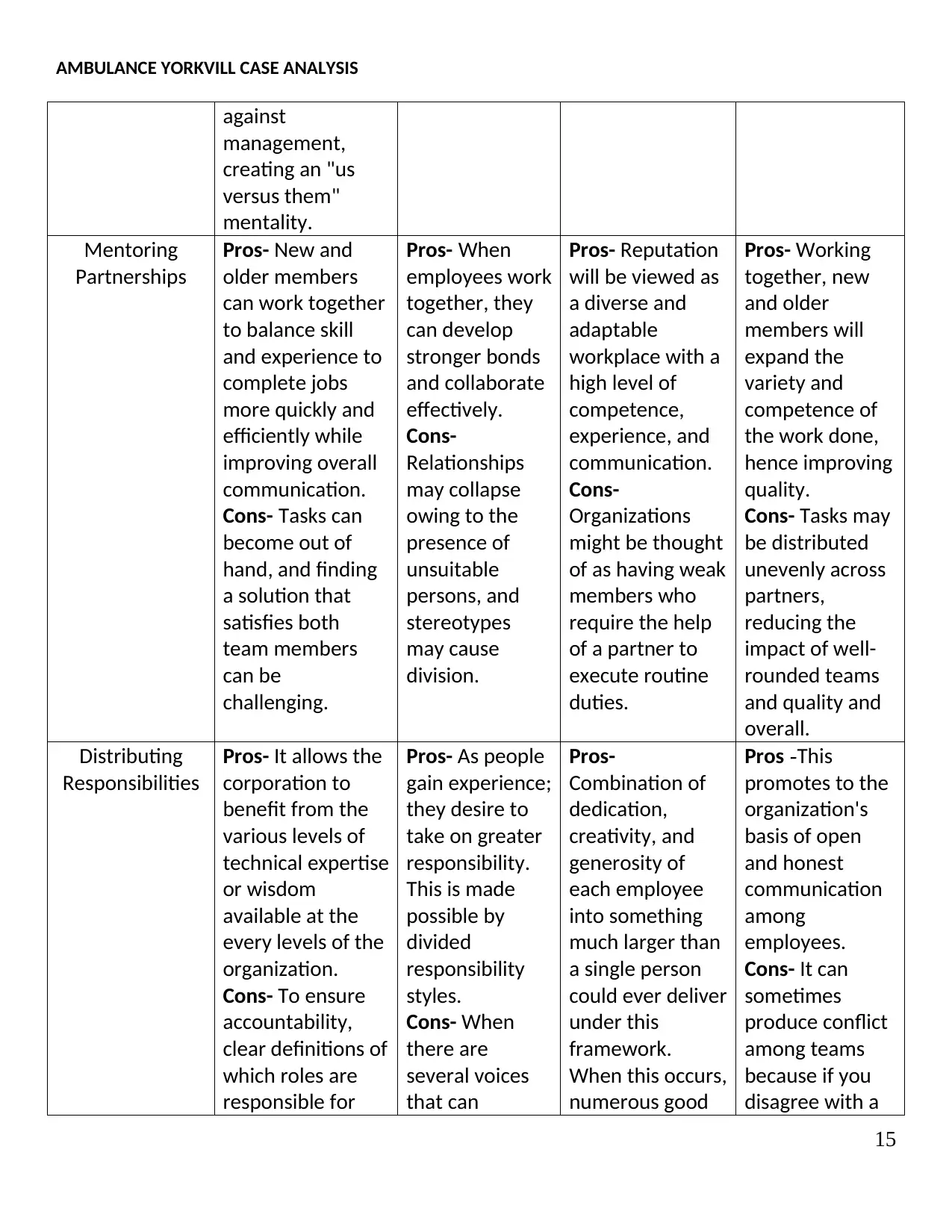
AMBULANCE YORKVILL CASE ANALYSIS
against
management,
creating an "us
versus them"
mentality.
Mentoring
Partnerships
Pros- New and
older members
can work together
to balance skill
and experience to
complete jobs
more quickly and
efficiently while
improving overall
communication.
Cons- Tasks can
become out of
hand, and finding
a solution that
satisfies both
team members
can be
challenging.
Pros- When
employees work
together, they
can develop
stronger bonds
and collaborate
effectively.
Cons-
Relationships
may collapse
owing to the
presence of
unsuitable
persons, and
stereotypes
may cause
division.
Pros- Reputation
will be viewed as
a diverse and
adaptable
workplace with a
high level of
competence,
experience, and
communication.
Cons-
Organizations
might be thought
of as having weak
members who
require the help
of a partner to
execute routine
duties.
Pros- Working
together, new
and older
members will
expand the
variety and
competence of
the work done,
hence improving
quality.
Cons- Tasks may
be distributed
unevenly across
partners,
reducing the
impact of well-
rounded teams
and quality and
overall.
Distributing
Responsibilities
Pros- It allows the
corporation to
benefit from the
various levels of
technical expertise
or wisdom
available at the
every levels of the
organization.
Cons- To ensure
accountability,
clear definitions of
which roles are
responsible for
Pros- As people
gain experience;
they desire to
take on greater
responsibility.
This is made
possible by
divided
responsibility
styles.
Cons- When
there are
several voices
that can
Pros-
Combination of
dedication,
creativity, and
generosity of
each employee
into something
much larger than
a single person
could ever deliver
under this
framework.
When this occurs,
numerous good
Pros -This
promotes to the
organization's
basis of open
and honest
communication
among
employees.
Cons- It can
sometimes
produce conflict
among teams
because if you
disagree with a
15
against
management,
creating an "us
versus them"
mentality.
Mentoring
Partnerships
Pros- New and
older members
can work together
to balance skill
and experience to
complete jobs
more quickly and
efficiently while
improving overall
communication.
Cons- Tasks can
become out of
hand, and finding
a solution that
satisfies both
team members
can be
challenging.
Pros- When
employees work
together, they
can develop
stronger bonds
and collaborate
effectively.
Cons-
Relationships
may collapse
owing to the
presence of
unsuitable
persons, and
stereotypes
may cause
division.
Pros- Reputation
will be viewed as
a diverse and
adaptable
workplace with a
high level of
competence,
experience, and
communication.
Cons-
Organizations
might be thought
of as having weak
members who
require the help
of a partner to
execute routine
duties.
Pros- Working
together, new
and older
members will
expand the
variety and
competence of
the work done,
hence improving
quality.
Cons- Tasks may
be distributed
unevenly across
partners,
reducing the
impact of well-
rounded teams
and quality and
overall.
Distributing
Responsibilities
Pros- It allows the
corporation to
benefit from the
various levels of
technical expertise
or wisdom
available at the
every levels of the
organization.
Cons- To ensure
accountability,
clear definitions of
which roles are
responsible for
Pros- As people
gain experience;
they desire to
take on greater
responsibility.
This is made
possible by
divided
responsibility
styles.
Cons- When
there are
several voices
that can
Pros-
Combination of
dedication,
creativity, and
generosity of
each employee
into something
much larger than
a single person
could ever deliver
under this
framework.
When this occurs,
numerous good
Pros -This
promotes to the
organization's
basis of open
and honest
communication
among
employees.
Cons- It can
sometimes
produce conflict
among teams
because if you
disagree with a
15
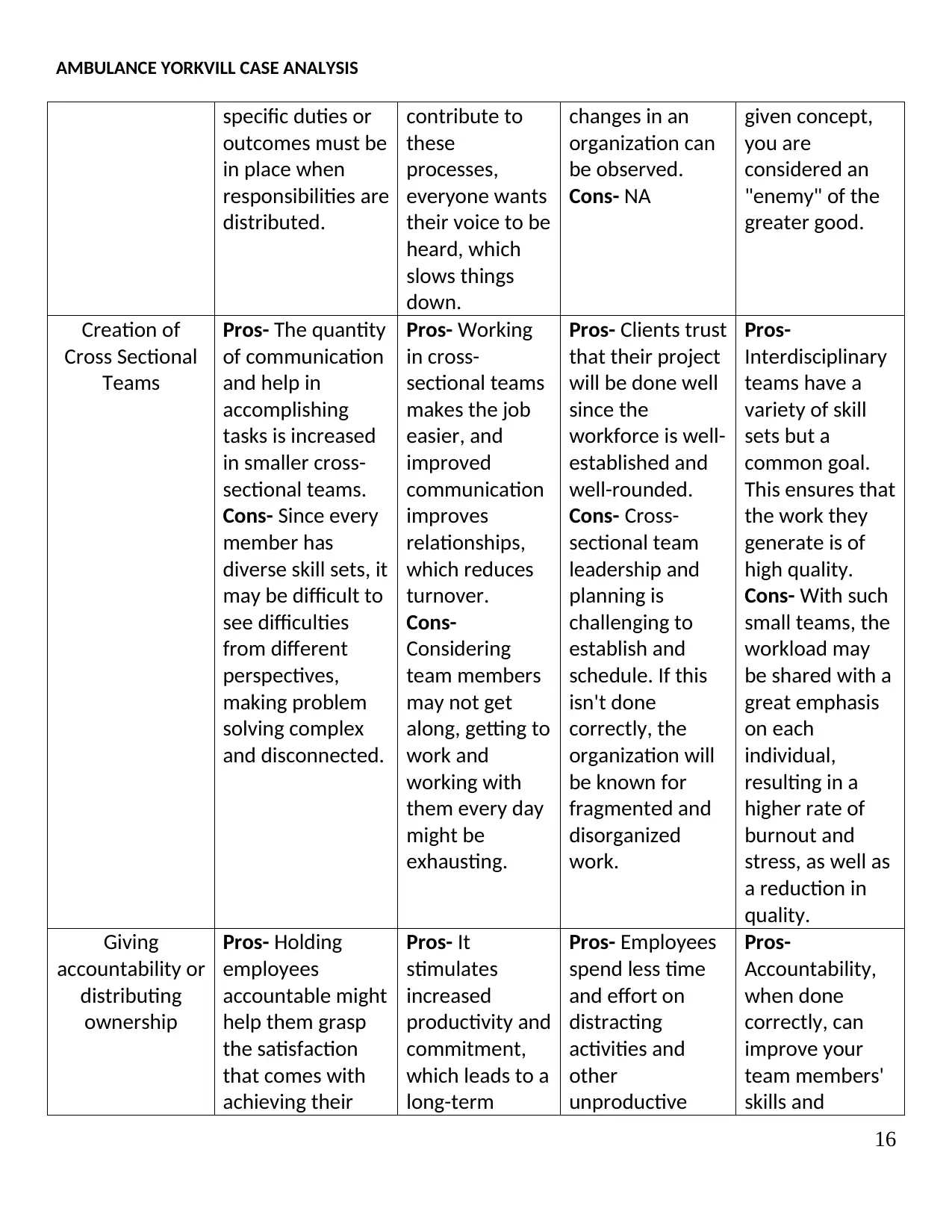
AMBULANCE YORKVILL CASE ANALYSIS
specific duties or
outcomes must be
in place when
responsibilities are
distributed.
contribute to
these
processes,
everyone wants
their voice to be
heard, which
slows things
down.
changes in an
organization can
be observed.
Cons- NA
given concept,
you are
considered an
"enemy" of the
greater good.
Creation of
Cross Sectional
Teams
Pros- The quantity
of communication
and help in
accomplishing
tasks is increased
in smaller cross-
sectional teams.
Cons- Since every
member has
diverse skill sets, it
may be difficult to
see difficulties
from different
perspectives,
making problem
solving complex
and disconnected.
Pros- Working
in cross-
sectional teams
makes the job
easier, and
improved
communication
improves
relationships,
which reduces
turnover.
Cons-
Considering
team members
may not get
along, getting to
work and
working with
them every day
might be
exhausting.
Pros- Clients trust
that their project
will be done well
since the
workforce is well-
established and
well-rounded.
Cons- Cross-
sectional team
leadership and
planning is
challenging to
establish and
schedule. If this
isn't done
correctly, the
organization will
be known for
fragmented and
disorganized
work.
Pros-
Interdisciplinary
teams have a
variety of skill
sets but a
common goal.
This ensures that
the work they
generate is of
high quality.
Cons- With such
small teams, the
workload may
be shared with a
great emphasis
on each
individual,
resulting in a
higher rate of
burnout and
stress, as well as
a reduction in
quality.
Giving
accountability or
distributing
ownership
Pros- Holding
employees
accountable might
help them grasp
the satisfaction
that comes with
achieving their
Pros- It
stimulates
increased
productivity and
commitment,
which leads to a
long-term
Pros- Employees
spend less time
and effort on
distracting
activities and
other
unproductive
Pros-
Accountability,
when done
correctly, can
improve your
team members'
skills and
16
specific duties or
outcomes must be
in place when
responsibilities are
distributed.
contribute to
these
processes,
everyone wants
their voice to be
heard, which
slows things
down.
changes in an
organization can
be observed.
Cons- NA
given concept,
you are
considered an
"enemy" of the
greater good.
Creation of
Cross Sectional
Teams
Pros- The quantity
of communication
and help in
accomplishing
tasks is increased
in smaller cross-
sectional teams.
Cons- Since every
member has
diverse skill sets, it
may be difficult to
see difficulties
from different
perspectives,
making problem
solving complex
and disconnected.
Pros- Working
in cross-
sectional teams
makes the job
easier, and
improved
communication
improves
relationships,
which reduces
turnover.
Cons-
Considering
team members
may not get
along, getting to
work and
working with
them every day
might be
exhausting.
Pros- Clients trust
that their project
will be done well
since the
workforce is well-
established and
well-rounded.
Cons- Cross-
sectional team
leadership and
planning is
challenging to
establish and
schedule. If this
isn't done
correctly, the
organization will
be known for
fragmented and
disorganized
work.
Pros-
Interdisciplinary
teams have a
variety of skill
sets but a
common goal.
This ensures that
the work they
generate is of
high quality.
Cons- With such
small teams, the
workload may
be shared with a
great emphasis
on each
individual,
resulting in a
higher rate of
burnout and
stress, as well as
a reduction in
quality.
Giving
accountability or
distributing
ownership
Pros- Holding
employees
accountable might
help them grasp
the satisfaction
that comes with
achieving their
Pros- It
stimulates
increased
productivity and
commitment,
which leads to a
long-term
Pros- Employees
spend less time
and effort on
distracting
activities and
other
unproductive
Pros-
Accountability,
when done
correctly, can
improve your
team members'
skills and
16
Secure Best Marks with AI Grader
Need help grading? Try our AI Grader for instant feedback on your assignments.
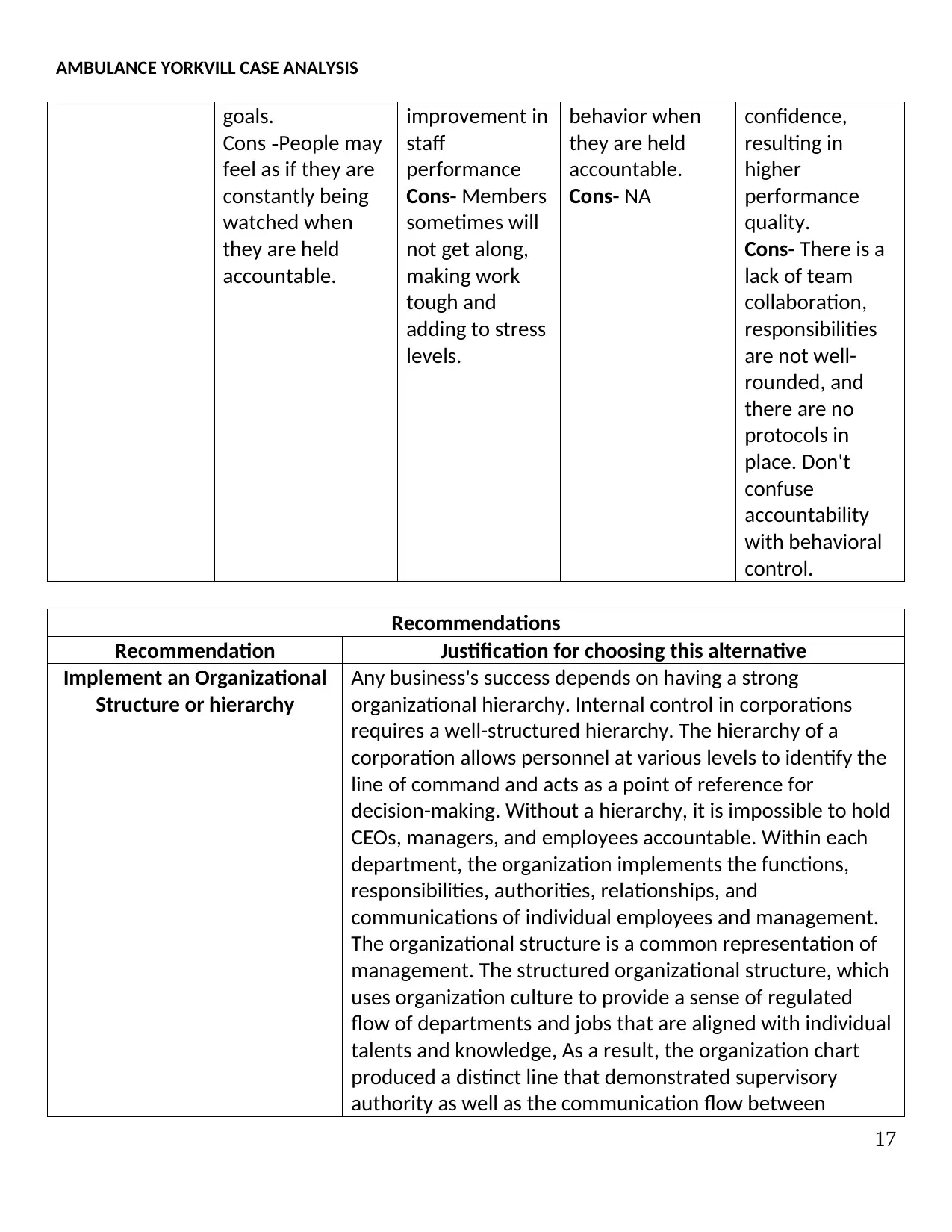
AMBULANCE YORKVILL CASE ANALYSIS
goals.
Cons -People may
feel as if they are
constantly being
watched when
they are held
accountable.
improvement in
staff
performance
Cons- Members
sometimes will
not get along,
making work
tough and
adding to stress
levels.
behavior when
they are held
accountable.
Cons- NA
confidence,
resulting in
higher
performance
quality.
Cons- There is a
lack of team
collaboration,
responsibilities
are not well-
rounded, and
there are no
protocols in
place. Don't
confuse
accountability
with behavioral
control.
Recommendations
Recommendation Justification for choosing this alternative
Implement an Organizational
Structure or hierarchy
Any business's success depends on having a strong
organizational hierarchy. Internal control in corporations
requires a well-structured hierarchy. The hierarchy of a
corporation allows personnel at various levels to identify the
line of command and acts as a point of reference for
decision-making. Without a hierarchy, it is impossible to hold
CEOs, managers, and employees accountable. Within each
department, the organization implements the functions,
responsibilities, authorities, relationships, and
communications of individual employees and management.
The organizational structure is a common representation of
management. The structured organizational structure, which
uses organization culture to provide a sense of regulated
flow of departments and jobs that are aligned with individual
talents and knowledge, As a result, the organization chart
produced a distinct line that demonstrated supervisory
authority as well as the communication flow between
17
goals.
Cons -People may
feel as if they are
constantly being
watched when
they are held
accountable.
improvement in
staff
performance
Cons- Members
sometimes will
not get along,
making work
tough and
adding to stress
levels.
behavior when
they are held
accountable.
Cons- NA
confidence,
resulting in
higher
performance
quality.
Cons- There is a
lack of team
collaboration,
responsibilities
are not well-
rounded, and
there are no
protocols in
place. Don't
confuse
accountability
with behavioral
control.
Recommendations
Recommendation Justification for choosing this alternative
Implement an Organizational
Structure or hierarchy
Any business's success depends on having a strong
organizational hierarchy. Internal control in corporations
requires a well-structured hierarchy. The hierarchy of a
corporation allows personnel at various levels to identify the
line of command and acts as a point of reference for
decision-making. Without a hierarchy, it is impossible to hold
CEOs, managers, and employees accountable. Within each
department, the organization implements the functions,
responsibilities, authorities, relationships, and
communications of individual employees and management.
The organizational structure is a common representation of
management. The structured organizational structure, which
uses organization culture to provide a sense of regulated
flow of departments and jobs that are aligned with individual
talents and knowledge, As a result, the organization chart
produced a distinct line that demonstrated supervisory
authority as well as the communication flow between
17
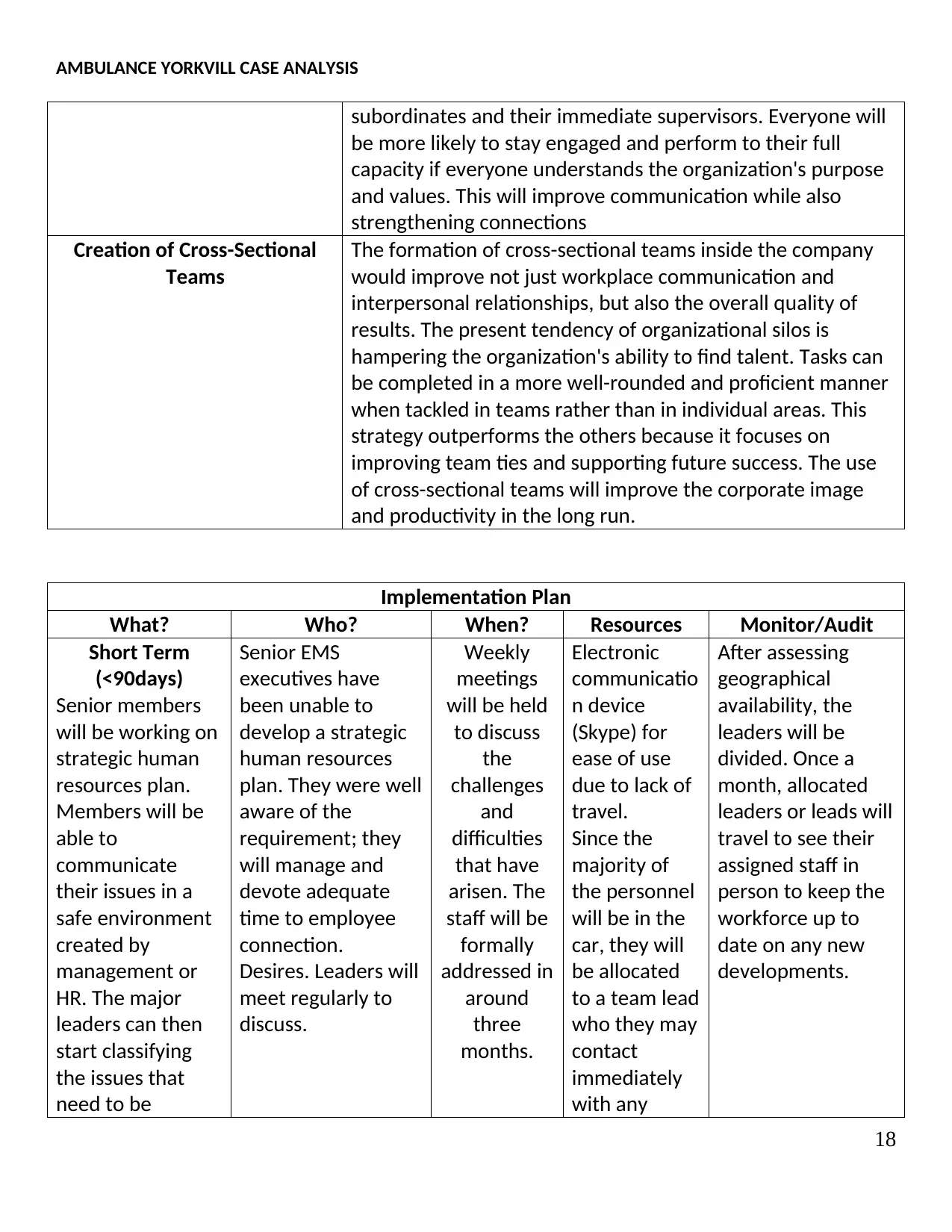
AMBULANCE YORKVILL CASE ANALYSIS
subordinates and their immediate supervisors. Everyone will
be more likely to stay engaged and perform to their full
capacity if everyone understands the organization's purpose
and values. This will improve communication while also
strengthening connections
Creation of Cross-Sectional
Teams
The formation of cross-sectional teams inside the company
would improve not just workplace communication and
interpersonal relationships, but also the overall quality of
results. The present tendency of organizational silos is
hampering the organization's ability to find talent. Tasks can
be completed in a more well-rounded and proficient manner
when tackled in teams rather than in individual areas. This
strategy outperforms the others because it focuses on
improving team ties and supporting future success. The use
of cross-sectional teams will improve the corporate image
and productivity in the long run.
Implementation Plan
What? Who? When? Resources Monitor/Audit
Short Term
(<90days)
Senior members
will be working on
strategic human
resources plan.
Members will be
able to
communicate
their issues in a
safe environment
created by
management or
HR. The major
leaders can then
start classifying
the issues that
need to be
Senior EMS
executives have
been unable to
develop a strategic
human resources
plan. They were well
aware of the
requirement; they
will manage and
devote adequate
time to employee
connection.
Desires. Leaders will
meet regularly to
discuss.
Weekly
meetings
will be held
to discuss
the
challenges
and
difficulties
that have
arisen. The
staff will be
formally
addressed in
around
three
months.
Electronic
communicatio
n device
(Skype) for
ease of use
due to lack of
travel.
Since the
majority of
the personnel
will be in the
car, they will
be allocated
to a team lead
who they may
contact
immediately
with any
After assessing
geographical
availability, the
leaders will be
divided. Once a
month, allocated
leaders or leads will
travel to see their
assigned staff in
person to keep the
workforce up to
date on any new
developments.
18
subordinates and their immediate supervisors. Everyone will
be more likely to stay engaged and perform to their full
capacity if everyone understands the organization's purpose
and values. This will improve communication while also
strengthening connections
Creation of Cross-Sectional
Teams
The formation of cross-sectional teams inside the company
would improve not just workplace communication and
interpersonal relationships, but also the overall quality of
results. The present tendency of organizational silos is
hampering the organization's ability to find talent. Tasks can
be completed in a more well-rounded and proficient manner
when tackled in teams rather than in individual areas. This
strategy outperforms the others because it focuses on
improving team ties and supporting future success. The use
of cross-sectional teams will improve the corporate image
and productivity in the long run.
Implementation Plan
What? Who? When? Resources Monitor/Audit
Short Term
(<90days)
Senior members
will be working on
strategic human
resources plan.
Members will be
able to
communicate
their issues in a
safe environment
created by
management or
HR. The major
leaders can then
start classifying
the issues that
need to be
Senior EMS
executives have
been unable to
develop a strategic
human resources
plan. They were well
aware of the
requirement; they
will manage and
devote adequate
time to employee
connection.
Desires. Leaders will
meet regularly to
discuss.
Weekly
meetings
will be held
to discuss
the
challenges
and
difficulties
that have
arisen. The
staff will be
formally
addressed in
around
three
months.
Electronic
communicatio
n device
(Skype) for
ease of use
due to lack of
travel.
Since the
majority of
the personnel
will be in the
car, they will
be allocated
to a team lead
who they may
contact
immediately
with any
After assessing
geographical
availability, the
leaders will be
divided. Once a
month, allocated
leaders or leads will
travel to see their
assigned staff in
person to keep the
workforce up to
date on any new
developments.
18
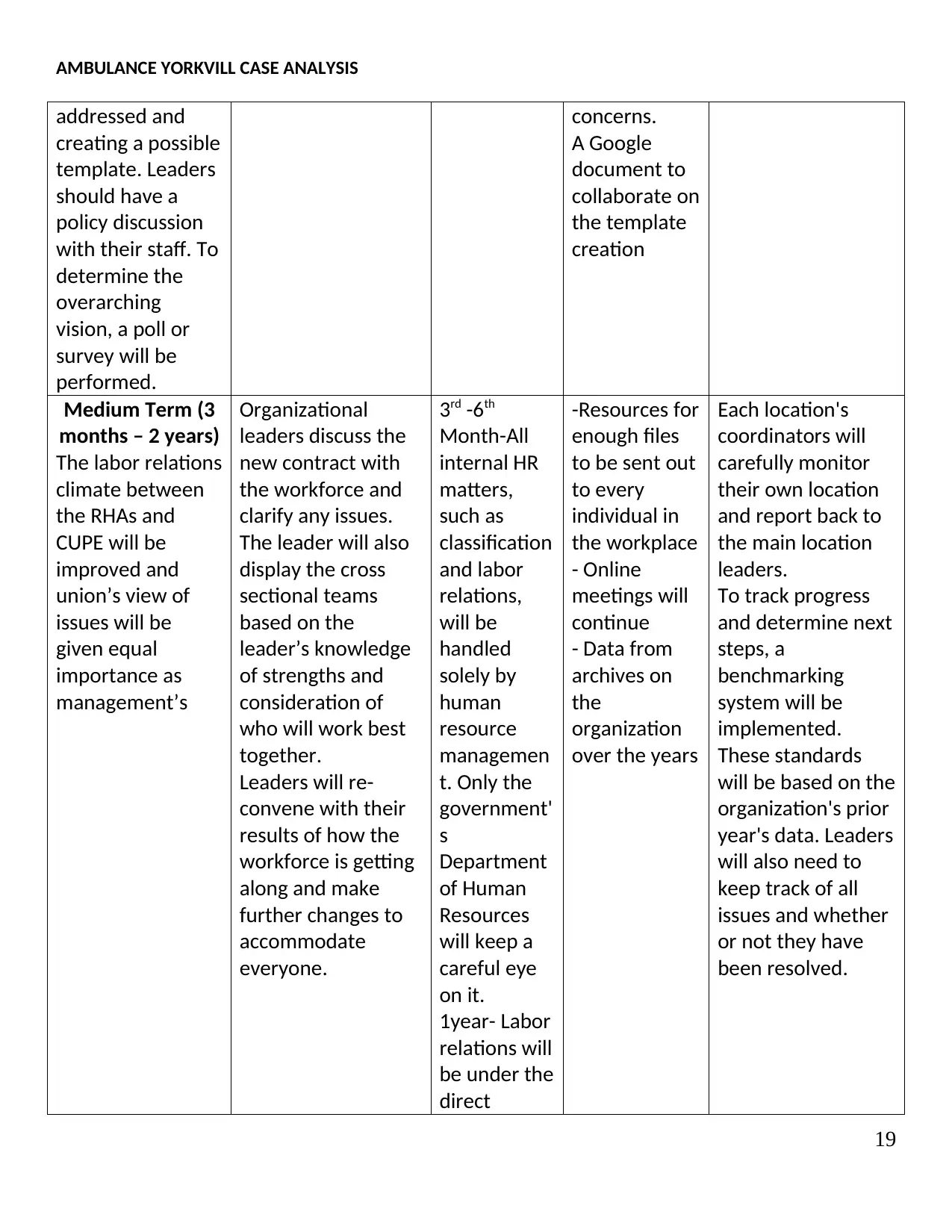
AMBULANCE YORKVILL CASE ANALYSIS
addressed and
creating a possible
template. Leaders
should have a
policy discussion
with their staff. To
determine the
overarching
vision, a poll or
survey will be
performed.
concerns.
A Google
document to
collaborate on
the template
creation
Medium Term (3
months – 2 years)
The labor relations
climate between
the RHAs and
CUPE will be
improved and
union’s view of
issues will be
given equal
importance as
management’s
Organizational
leaders discuss the
new contract with
the workforce and
clarify any issues.
The leader will also
display the cross
sectional teams
based on the
leader’s knowledge
of strengths and
consideration of
who will work best
together.
Leaders will re-
convene with their
results of how the
workforce is getting
along and make
further changes to
accommodate
everyone.
3rd -6th
Month-All
internal HR
matters,
such as
classification
and labor
relations,
will be
handled
solely by
human
resource
managemen
t. Only the
government'
s
Department
of Human
Resources
will keep a
careful eye
on it.
1year- Labor
relations will
be under the
direct
-Resources for
enough files
to be sent out
to every
individual in
the workplace
- Online
meetings will
continue
- Data from
archives on
the
organization
over the years
Each location's
coordinators will
carefully monitor
their own location
and report back to
the main location
leaders.
To track progress
and determine next
steps, a
benchmarking
system will be
implemented.
These standards
will be based on the
organization's prior
year's data. Leaders
will also need to
keep track of all
issues and whether
or not they have
been resolved.
19
addressed and
creating a possible
template. Leaders
should have a
policy discussion
with their staff. To
determine the
overarching
vision, a poll or
survey will be
performed.
concerns.
A Google
document to
collaborate on
the template
creation
Medium Term (3
months – 2 years)
The labor relations
climate between
the RHAs and
CUPE will be
improved and
union’s view of
issues will be
given equal
importance as
management’s
Organizational
leaders discuss the
new contract with
the workforce and
clarify any issues.
The leader will also
display the cross
sectional teams
based on the
leader’s knowledge
of strengths and
consideration of
who will work best
together.
Leaders will re-
convene with their
results of how the
workforce is getting
along and make
further changes to
accommodate
everyone.
3rd -6th
Month-All
internal HR
matters,
such as
classification
and labor
relations,
will be
handled
solely by
human
resource
managemen
t. Only the
government'
s
Department
of Human
Resources
will keep a
careful eye
on it.
1year- Labor
relations will
be under the
direct
-Resources for
enough files
to be sent out
to every
individual in
the workplace
- Online
meetings will
continue
- Data from
archives on
the
organization
over the years
Each location's
coordinators will
carefully monitor
their own location
and report back to
the main location
leaders.
To track progress
and determine next
steps, a
benchmarking
system will be
implemented.
These standards
will be based on the
organization's prior
year's data. Leaders
will also need to
keep track of all
issues and whether
or not they have
been resolved.
19
Paraphrase This Document
Need a fresh take? Get an instant paraphrase of this document with our AI Paraphraser
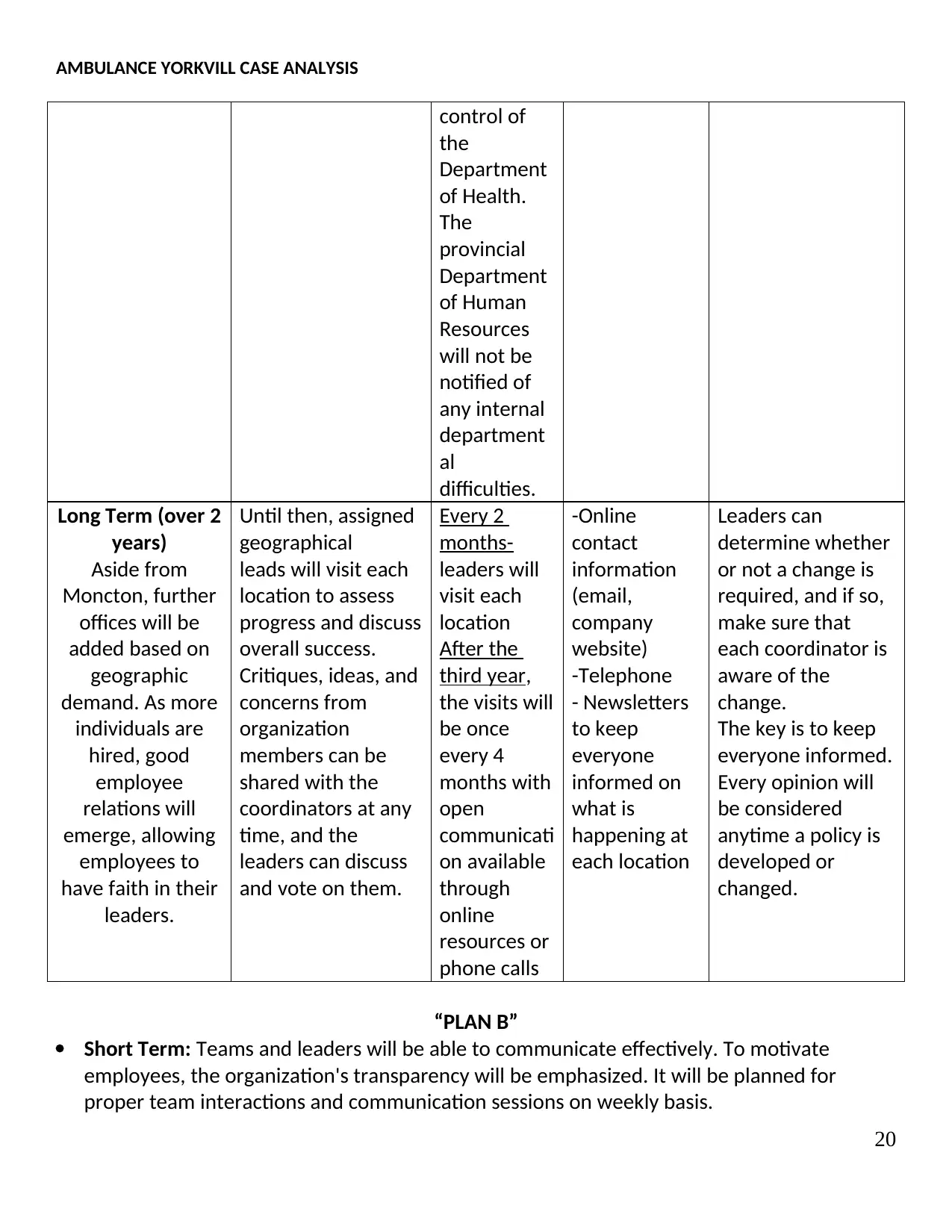
AMBULANCE YORKVILL CASE ANALYSIS
control of
the
Department
of Health.
The
provincial
Department
of Human
Resources
will not be
notified of
any internal
department
al
difficulties.
Long Term (over 2
years)
Aside from
Moncton, further
offices will be
added based on
geographic
demand. As more
individuals are
hired, good
employee
relations will
emerge, allowing
employees to
have faith in their
leaders.
Until then, assigned
geographical
leads will visit each
location to assess
progress and discuss
overall success.
Critiques, ideas, and
concerns from
organization
members can be
shared with the
coordinators at any
time, and the
leaders can discuss
and vote on them.
Every 2
months-
leaders will
visit each
location
After the
third year,
the visits will
be once
every 4
months with
open
communicati
on available
through
online
resources or
phone calls
-Online
contact
information
(email,
company
website)
-Telephone
- Newsletters
to keep
everyone
informed on
what is
happening at
each location
Leaders can
determine whether
or not a change is
required, and if so,
make sure that
each coordinator is
aware of the
change.
The key is to keep
everyone informed.
Every opinion will
be considered
anytime a policy is
developed or
changed.
“PLAN B”
Short Term: Teams and leaders will be able to communicate effectively. To motivate
employees, the organization's transparency will be emphasized. It will be planned for
proper team interactions and communication sessions on weekly basis.
20
control of
the
Department
of Health.
The
provincial
Department
of Human
Resources
will not be
notified of
any internal
department
al
difficulties.
Long Term (over 2
years)
Aside from
Moncton, further
offices will be
added based on
geographic
demand. As more
individuals are
hired, good
employee
relations will
emerge, allowing
employees to
have faith in their
leaders.
Until then, assigned
geographical
leads will visit each
location to assess
progress and discuss
overall success.
Critiques, ideas, and
concerns from
organization
members can be
shared with the
coordinators at any
time, and the
leaders can discuss
and vote on them.
Every 2
months-
leaders will
visit each
location
After the
third year,
the visits will
be once
every 4
months with
open
communicati
on available
through
online
resources or
phone calls
-Online
contact
information
(email,
company
website)
-Telephone
- Newsletters
to keep
everyone
informed on
what is
happening at
each location
Leaders can
determine whether
or not a change is
required, and if so,
make sure that
each coordinator is
aware of the
change.
The key is to keep
everyone informed.
Every opinion will
be considered
anytime a policy is
developed or
changed.
“PLAN B”
Short Term: Teams and leaders will be able to communicate effectively. To motivate
employees, the organization's transparency will be emphasized. It will be planned for
proper team interactions and communication sessions on weekly basis.
20

AMBULANCE YORKVILL CASE ANALYSIS
Medium Term: New policies will be implemented after considering all viewpoints in order
to improve employee relationship.
Long Term: To share the strain, proper hierarchy and responsibilities shall be divided. New
staff will be hired if necessary to ensure that no one is overloaded.
21
Medium Term: New policies will be implemented after considering all viewpoints in order
to improve employee relationship.
Long Term: To share the strain, proper hierarchy and responsibilities shall be divided. New
staff will be hired if necessary to ensure that no one is overloaded.
21
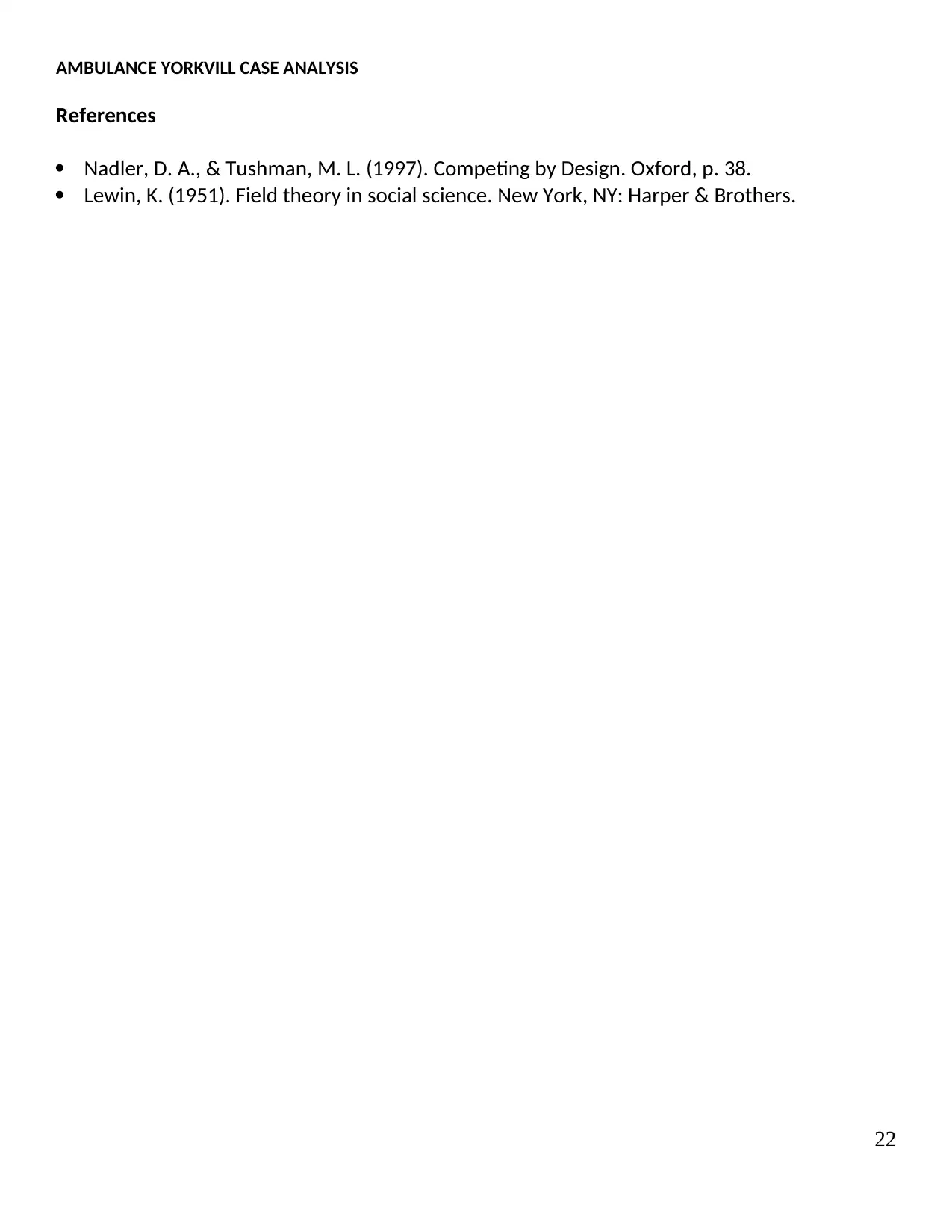
AMBULANCE YORKVILL CASE ANALYSIS
References
Nadler, D. A., & Tushman, M. L. (1997). Competing by Design. Oxford, p. 38.
Lewin, K. (1951). Field theory in social science. New York, NY: Harper & Brothers.
22
References
Nadler, D. A., & Tushman, M. L. (1997). Competing by Design. Oxford, p. 38.
Lewin, K. (1951). Field theory in social science. New York, NY: Harper & Brothers.
22
1 out of 22
Your All-in-One AI-Powered Toolkit for Academic Success.
+13062052269
info@desklib.com
Available 24*7 on WhatsApp / Email
![[object Object]](/_next/static/media/star-bottom.7253800d.svg)
Unlock your academic potential
© 2024 | Zucol Services PVT LTD | All rights reserved.





